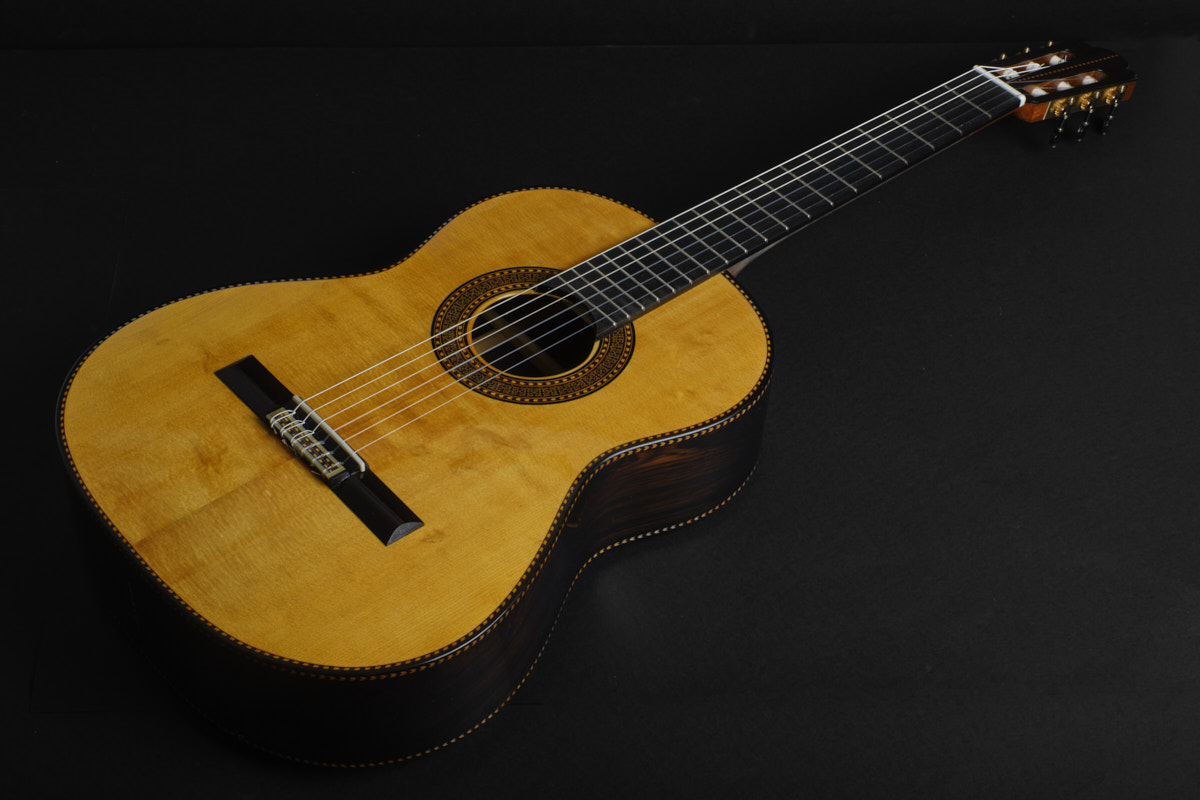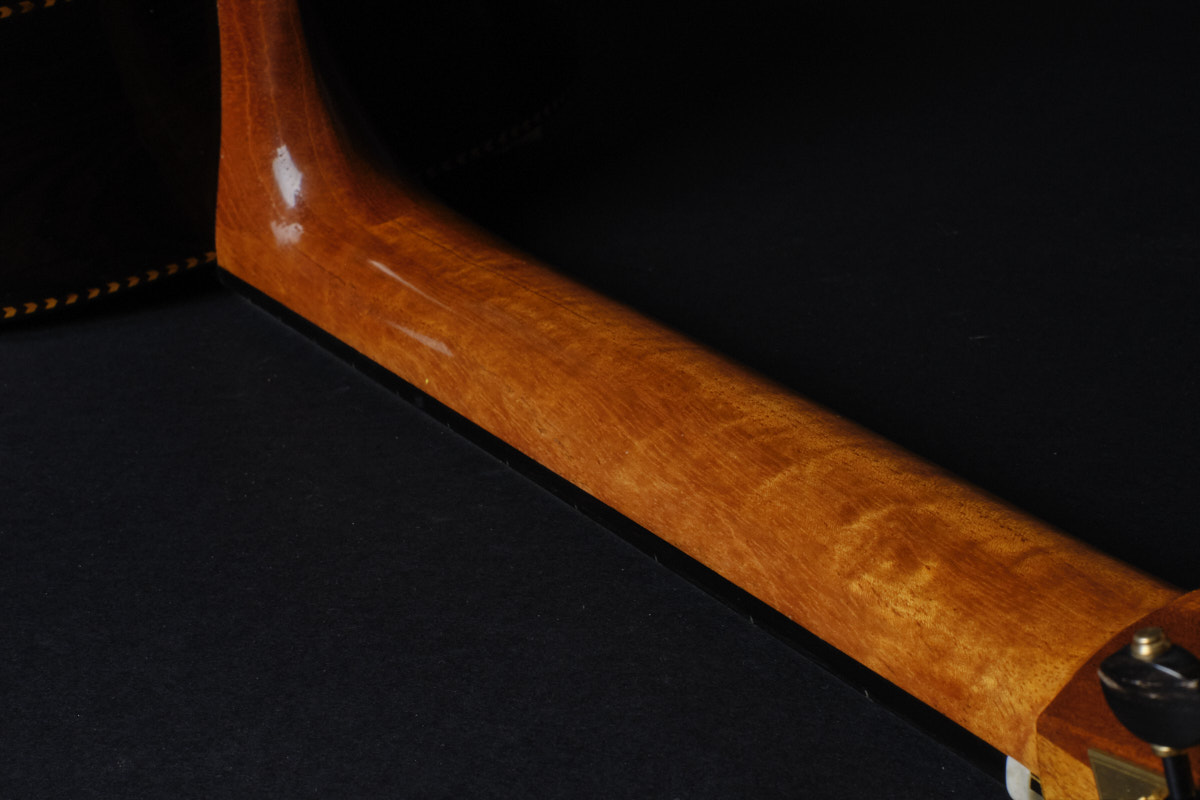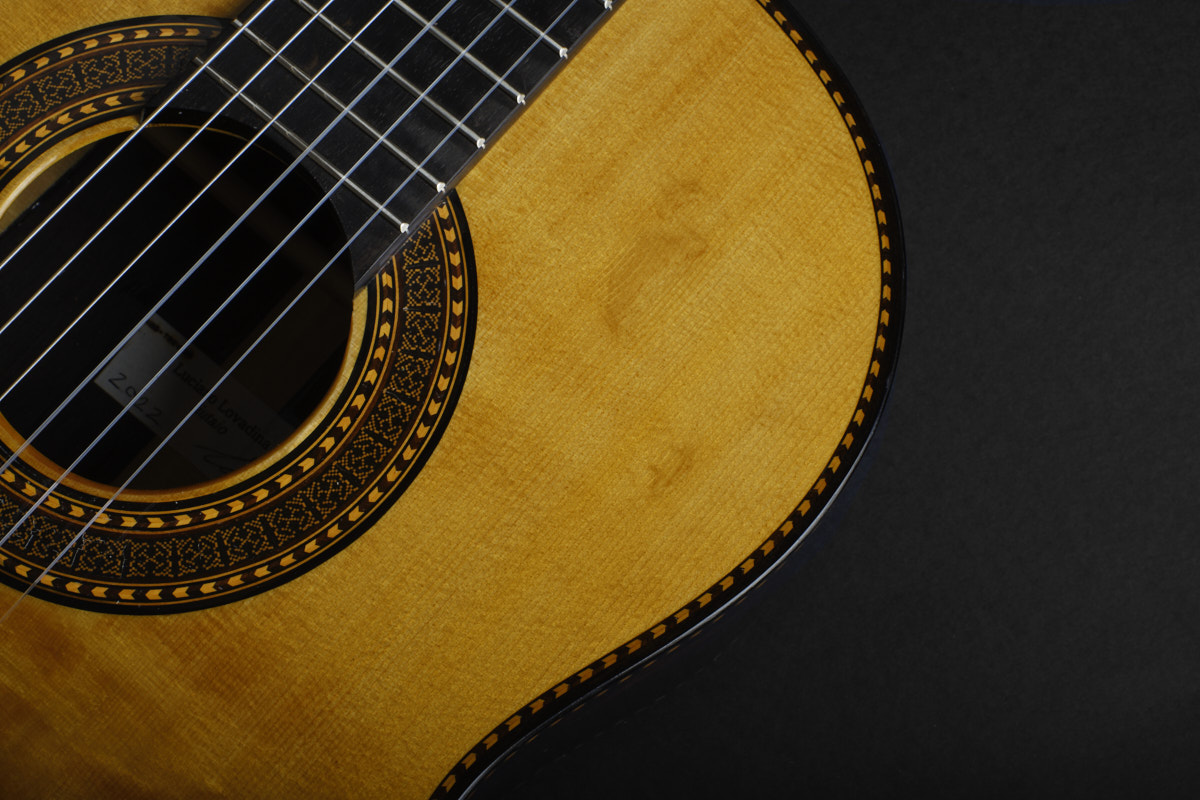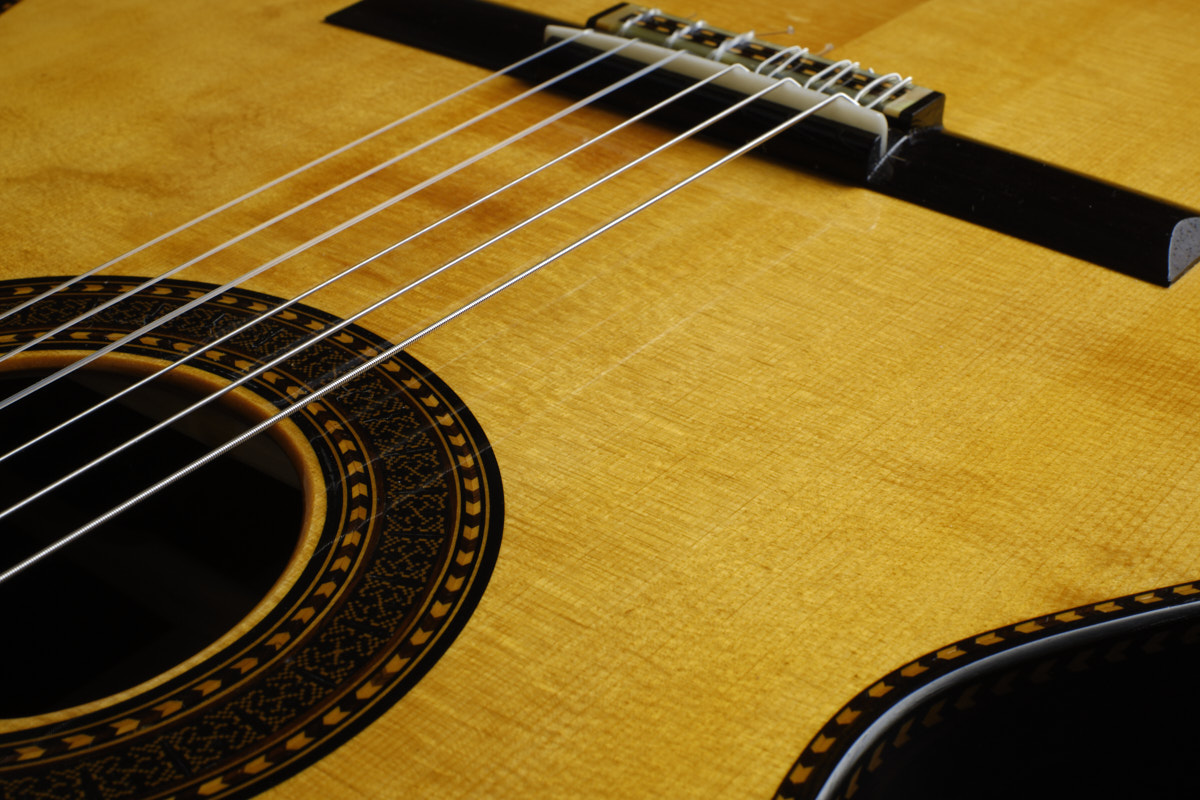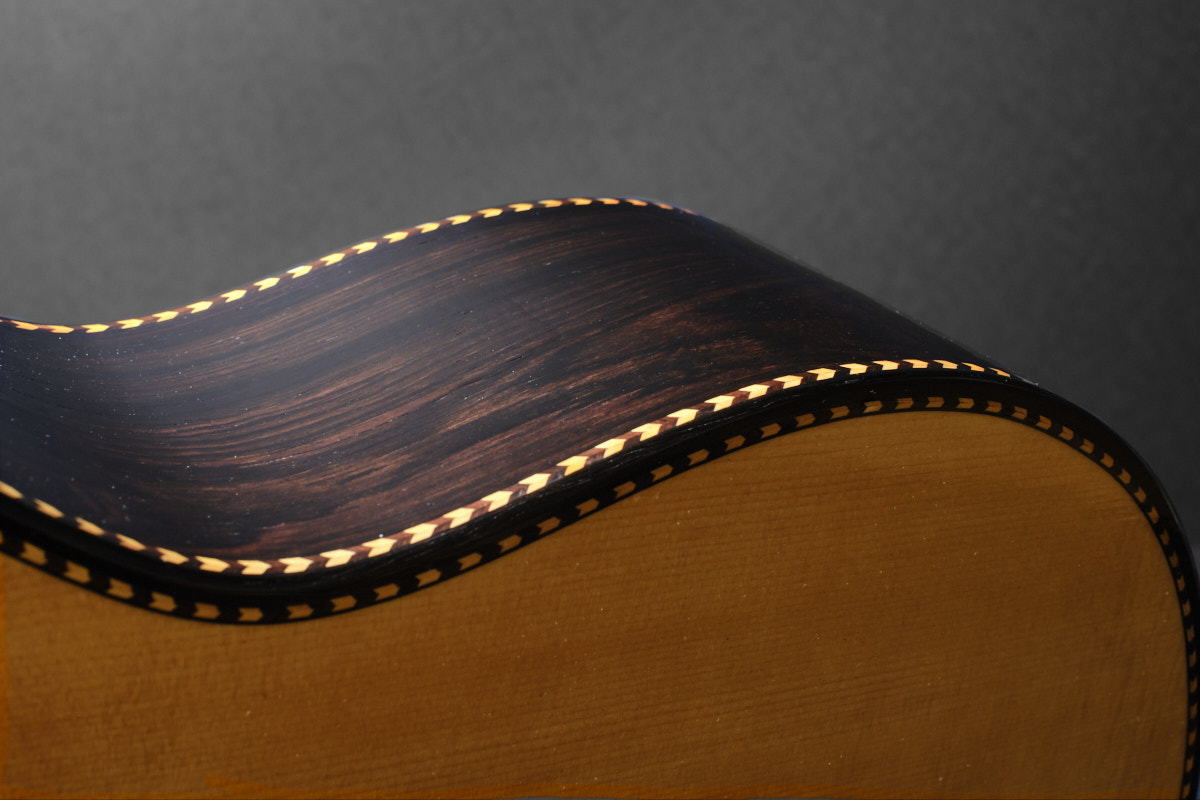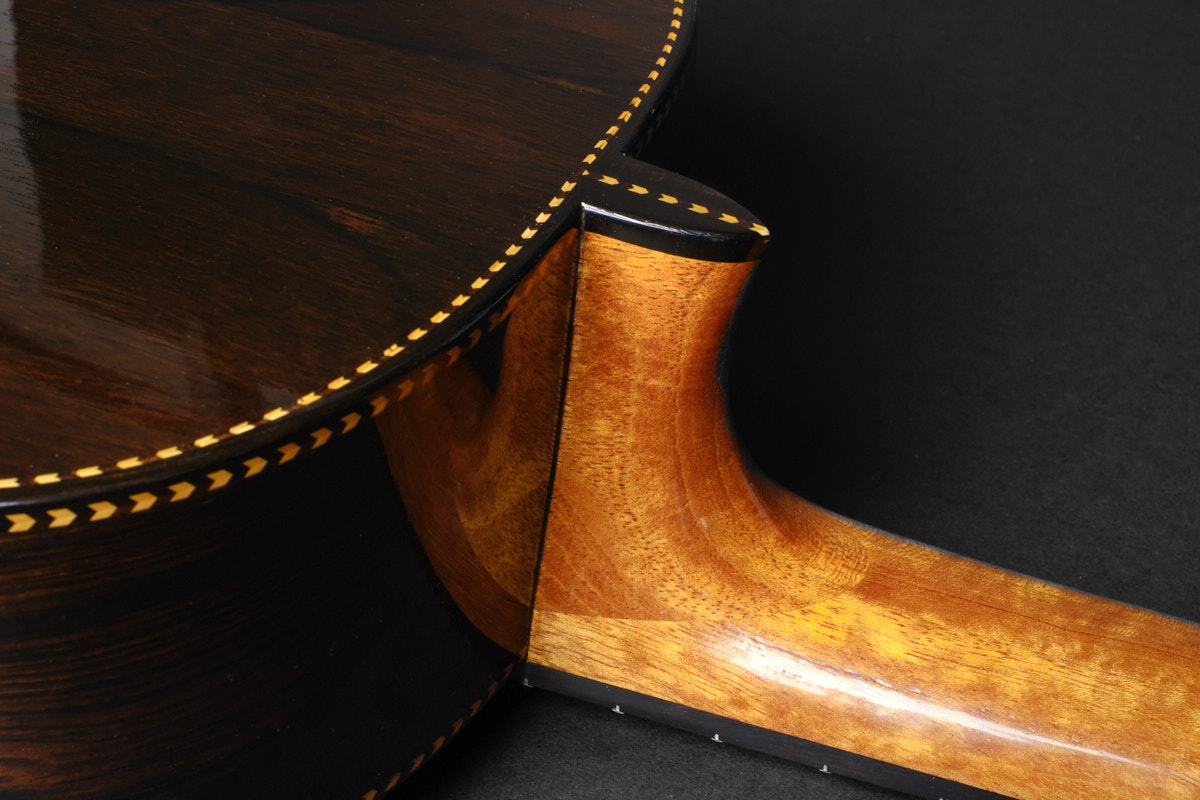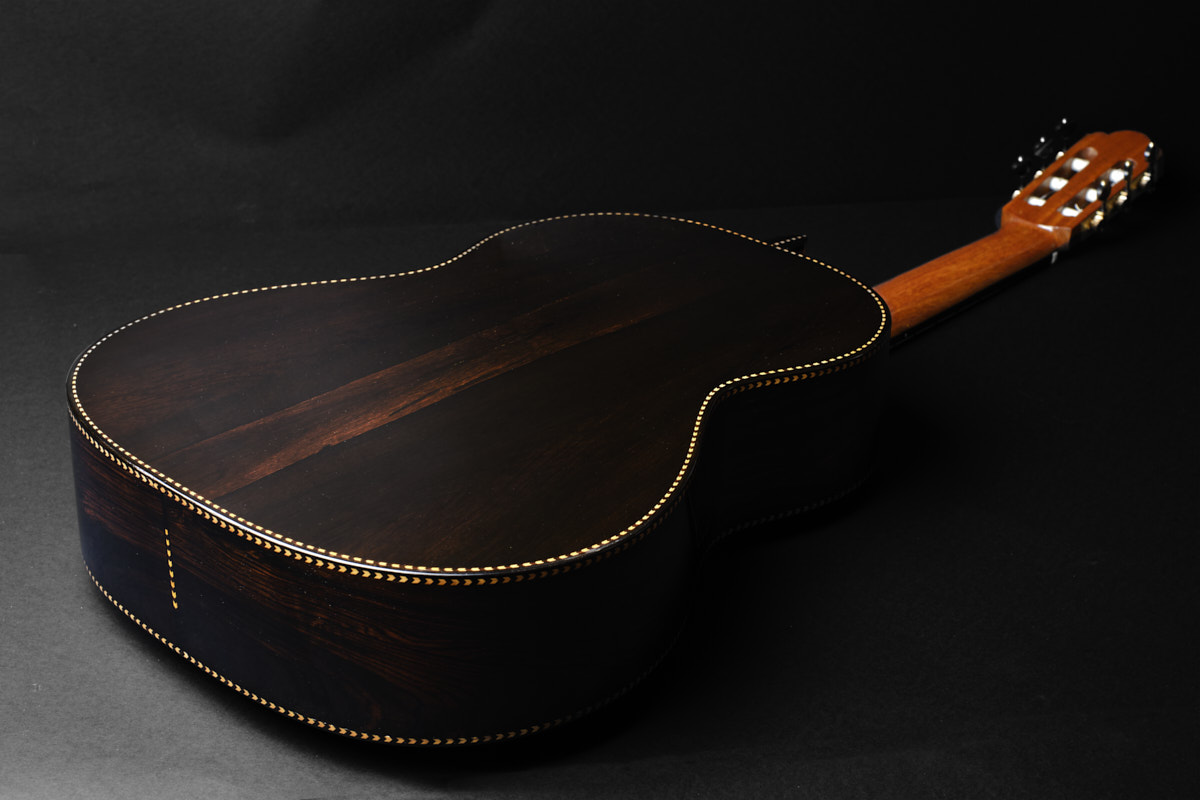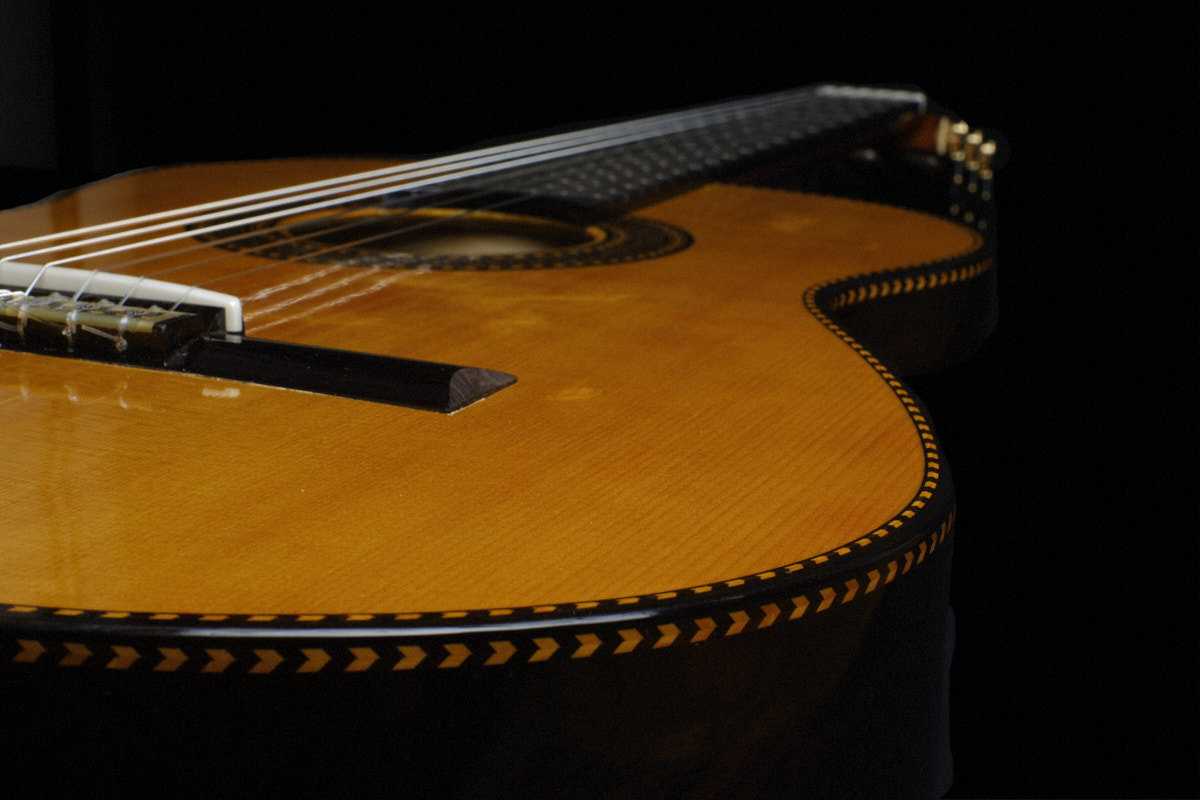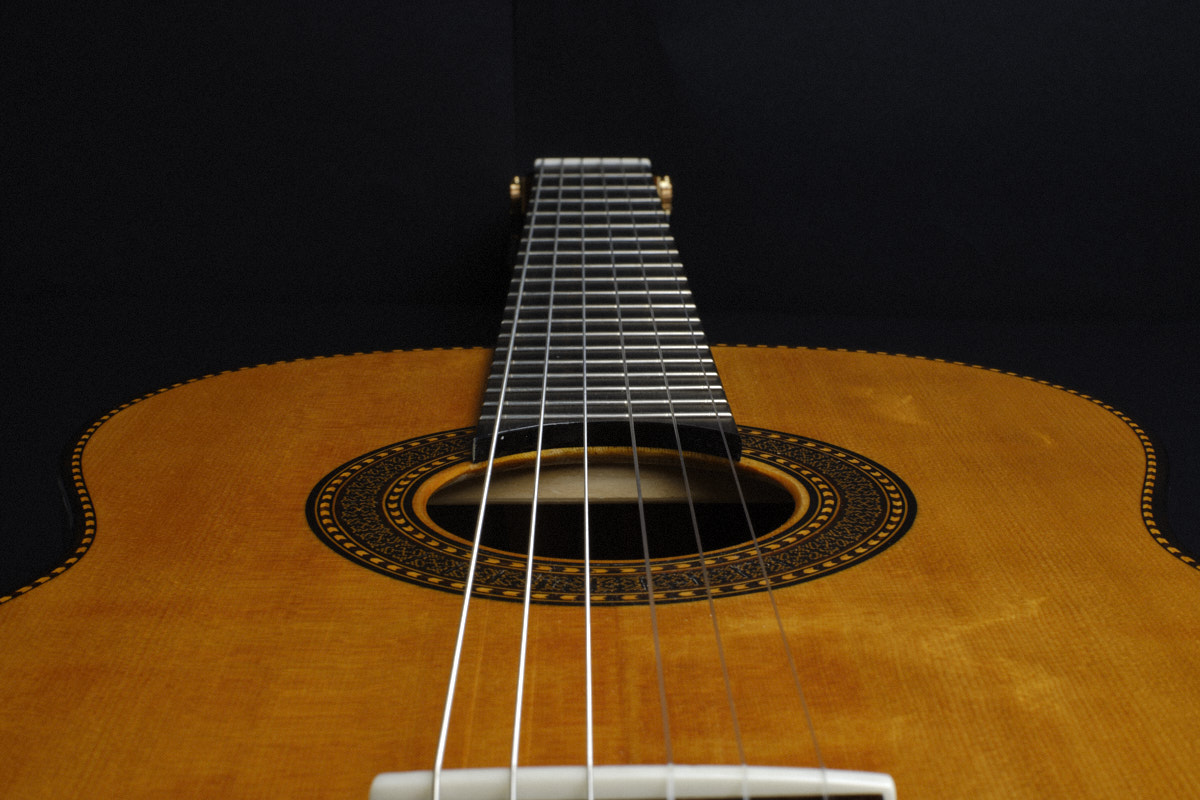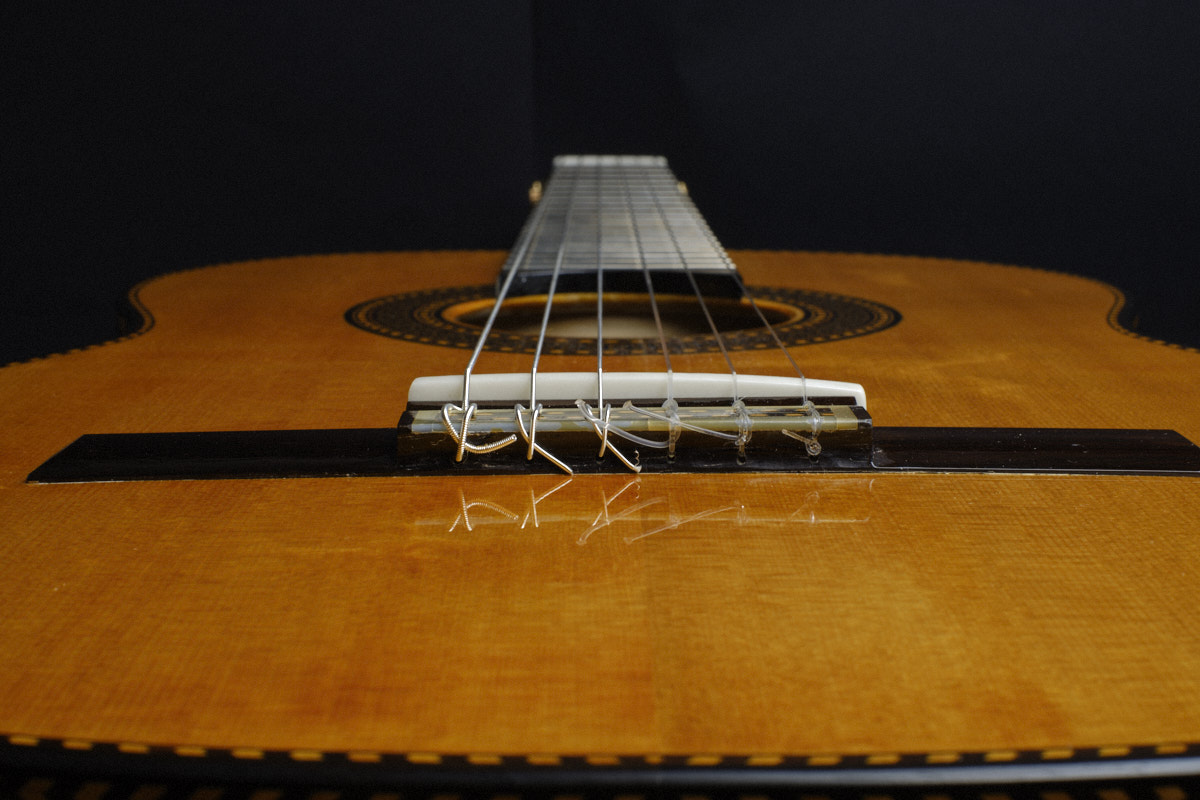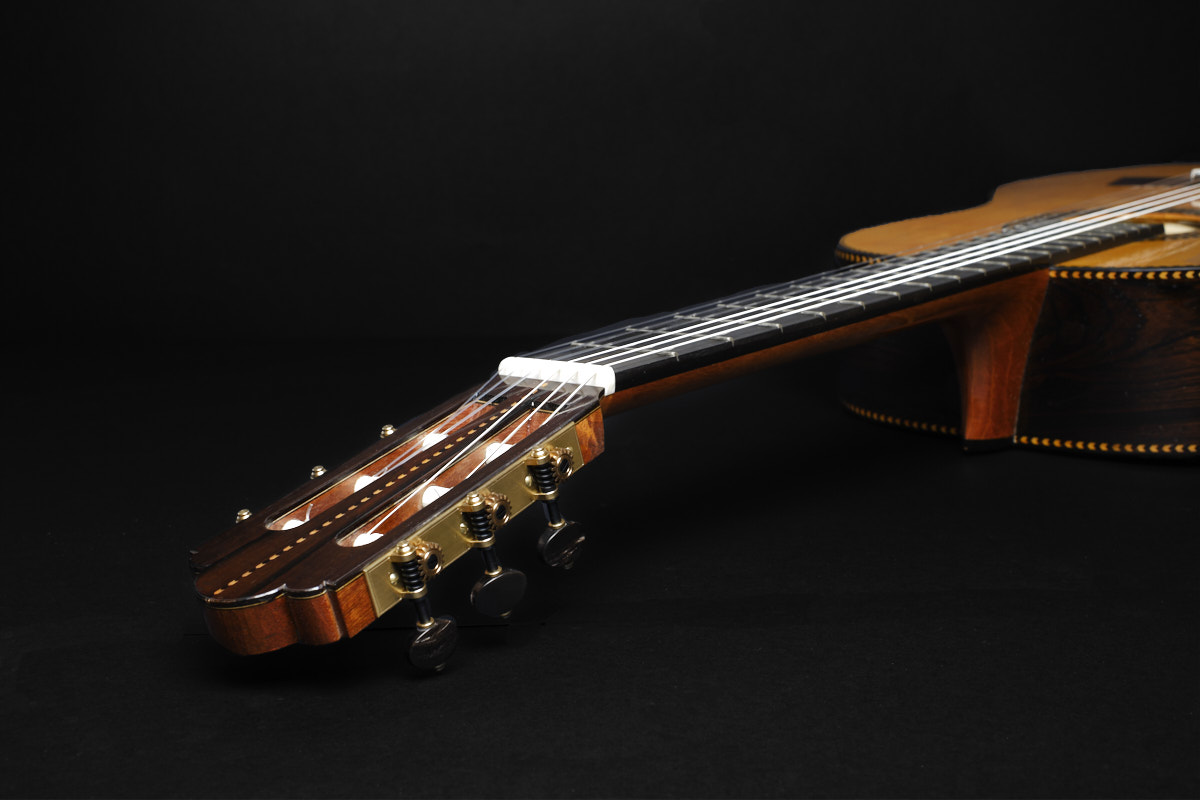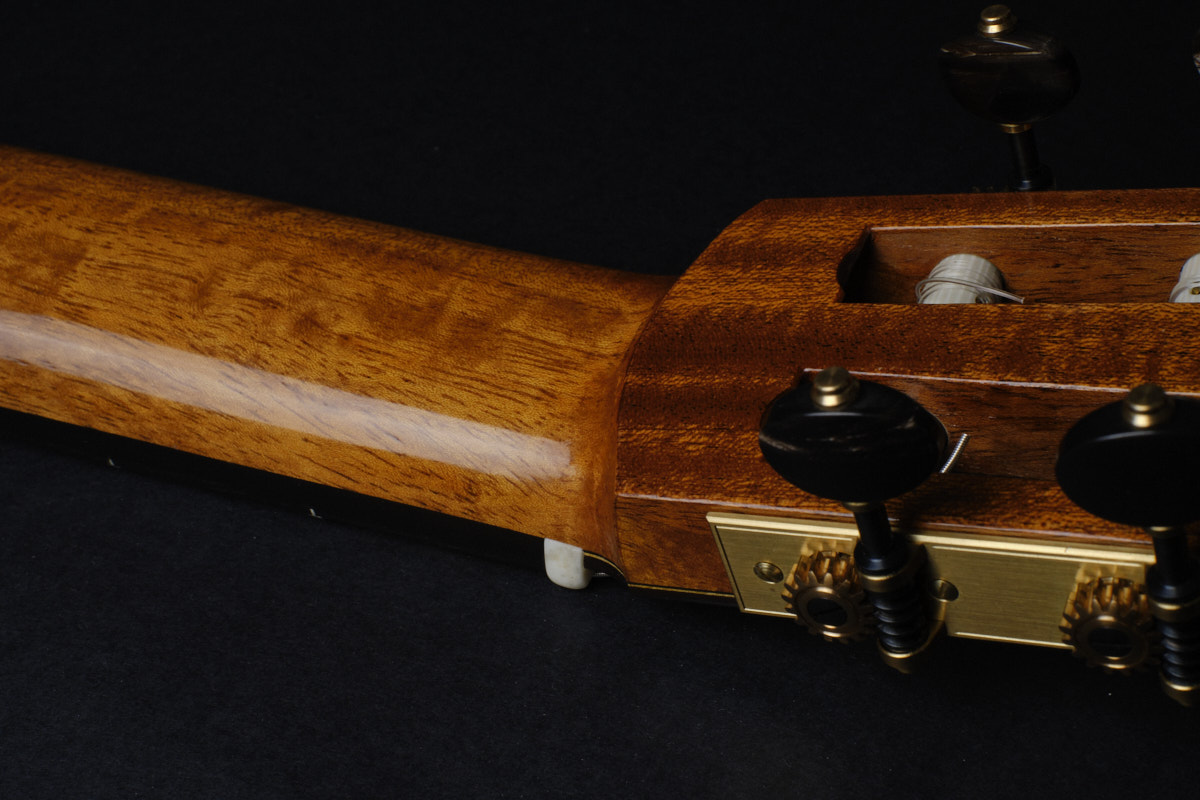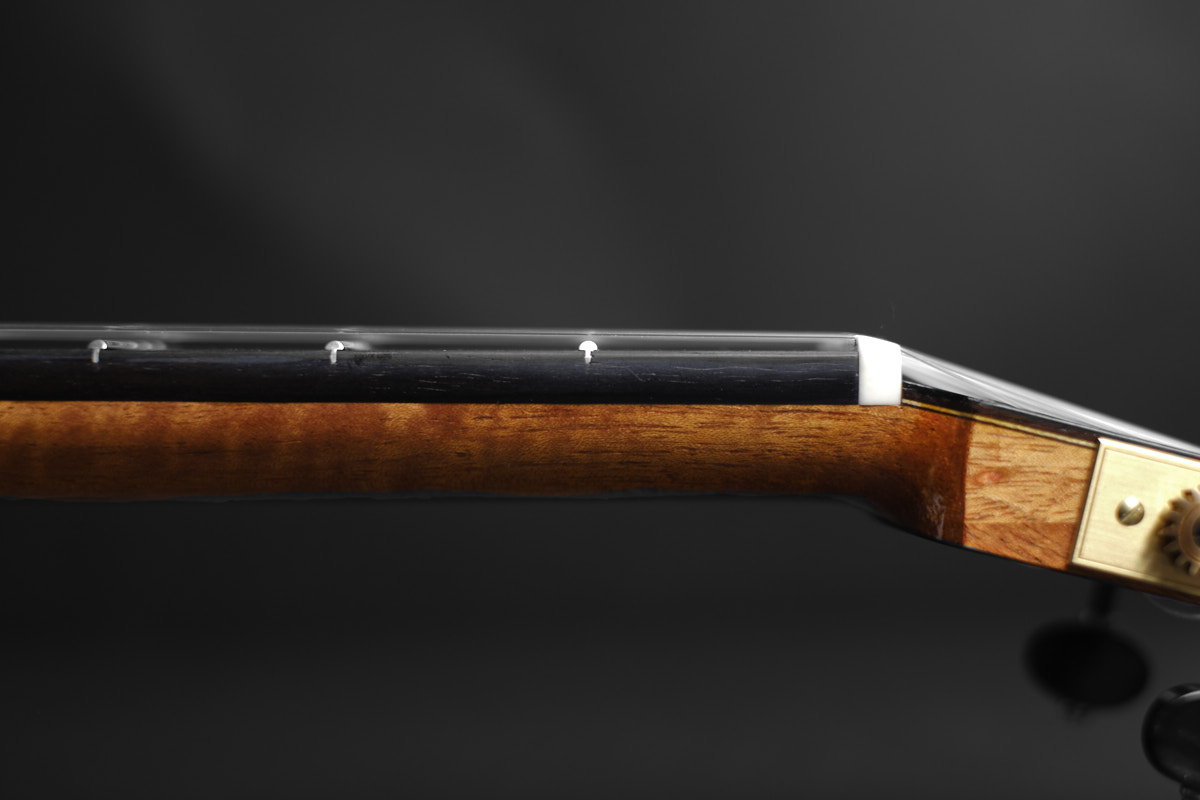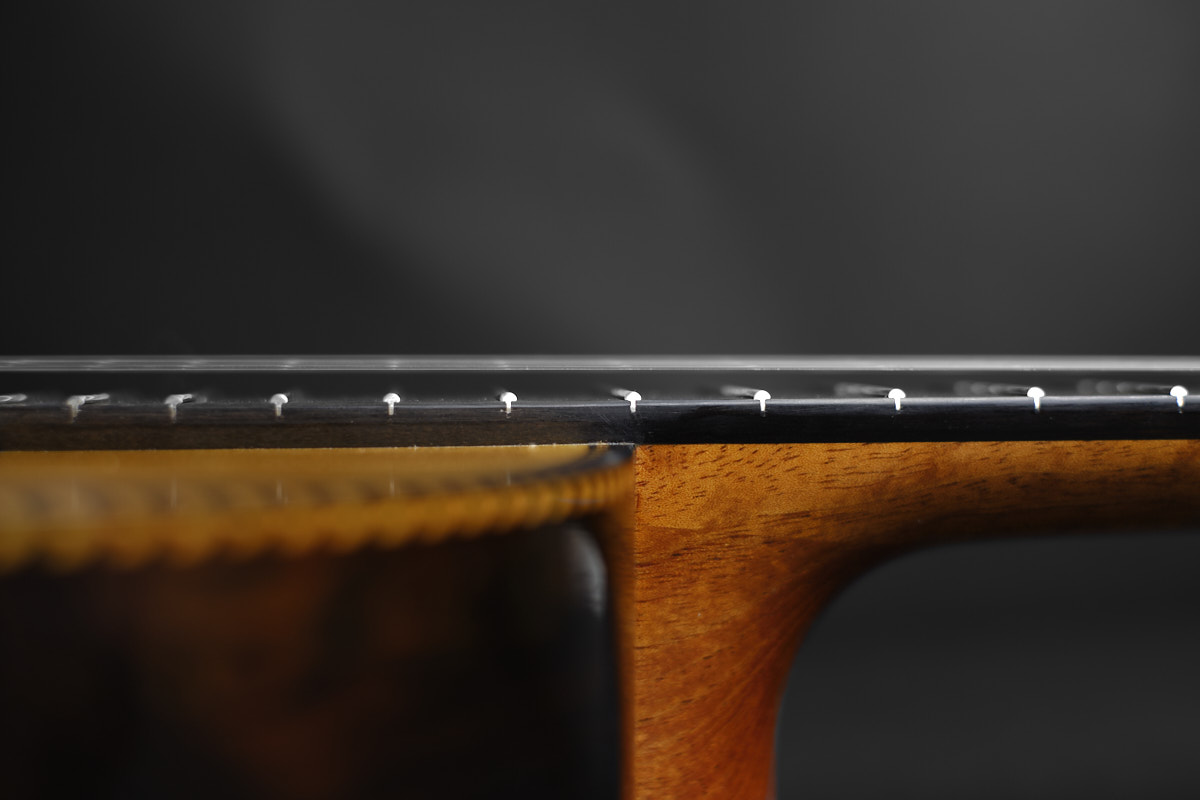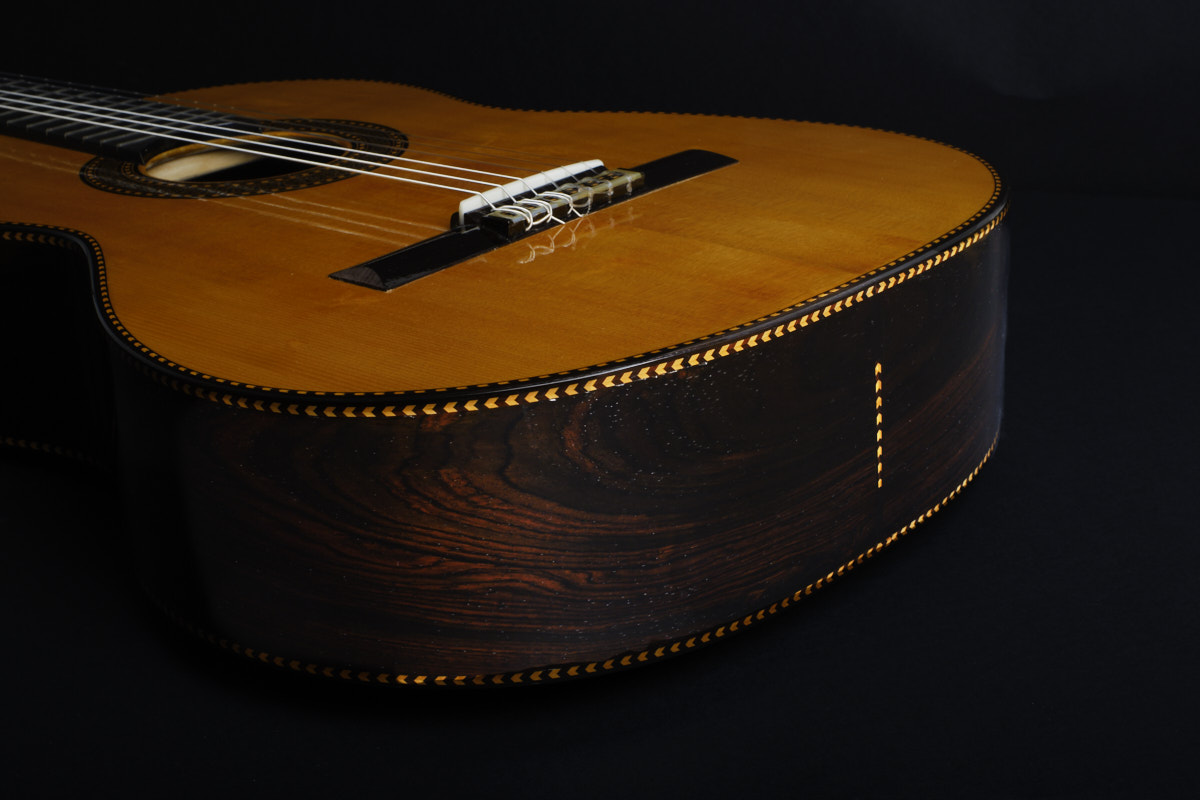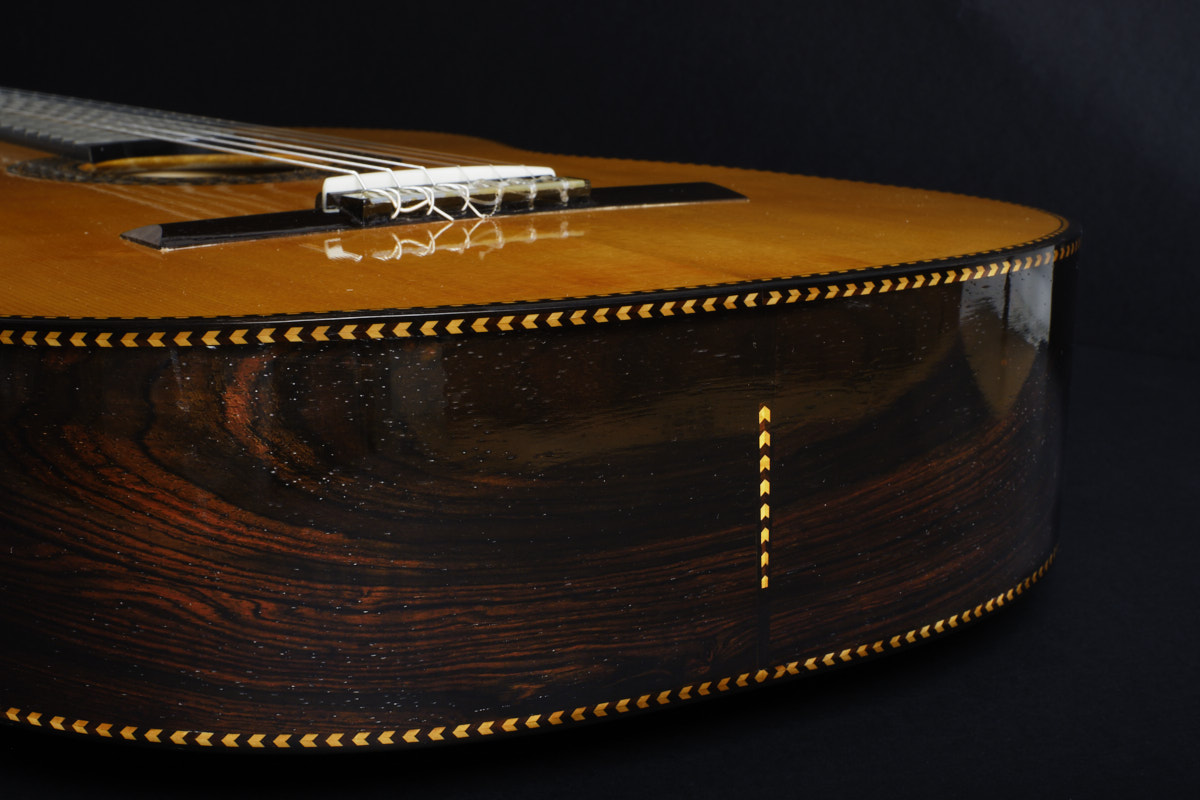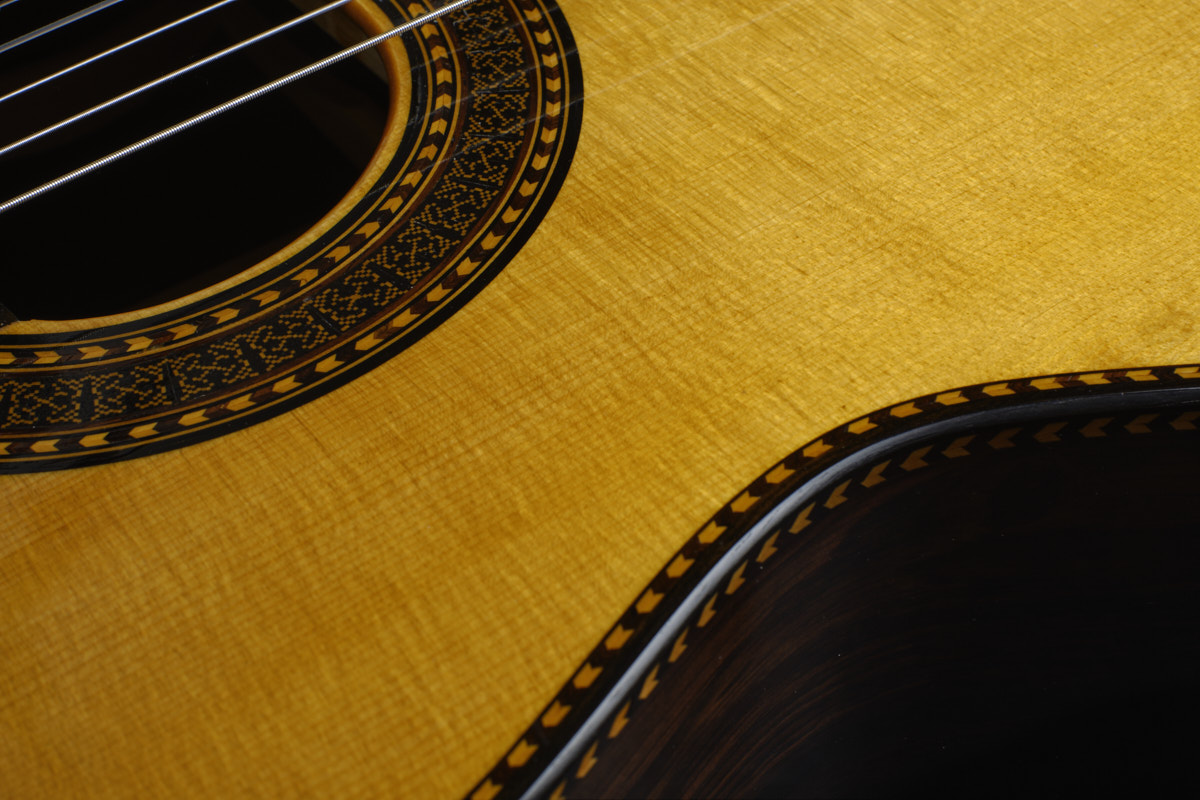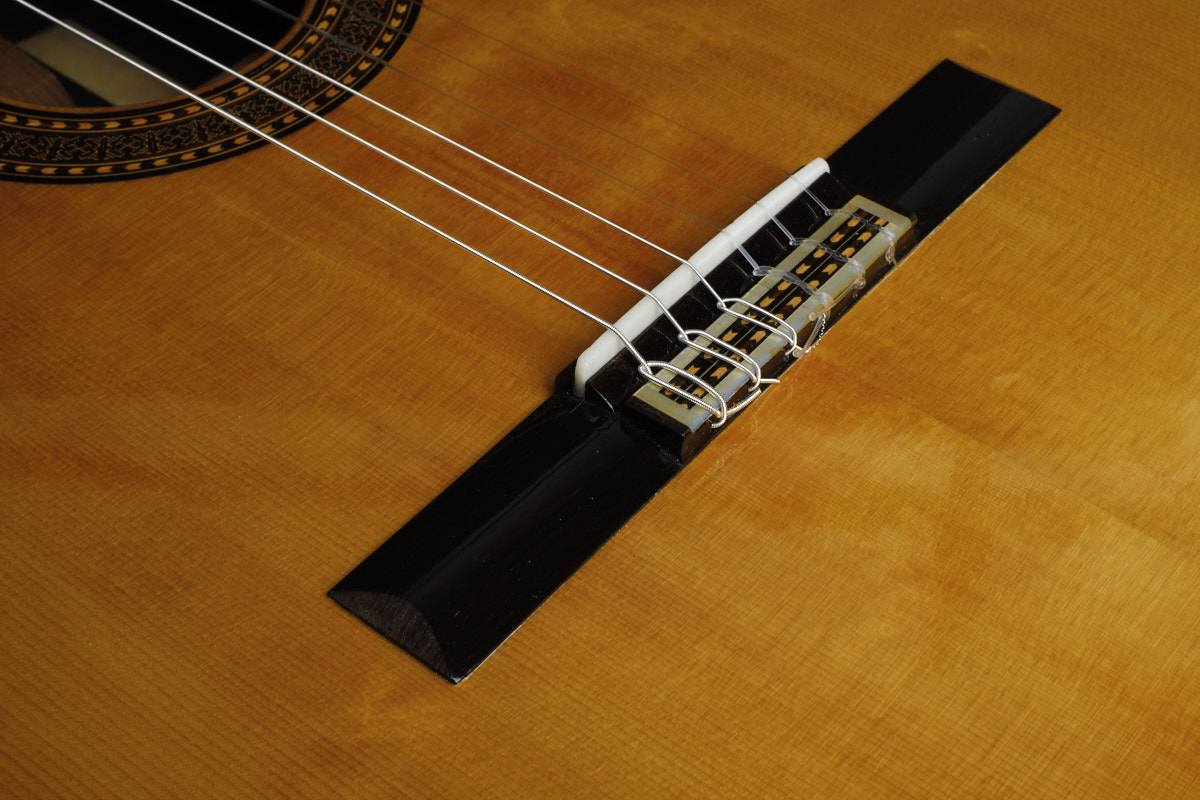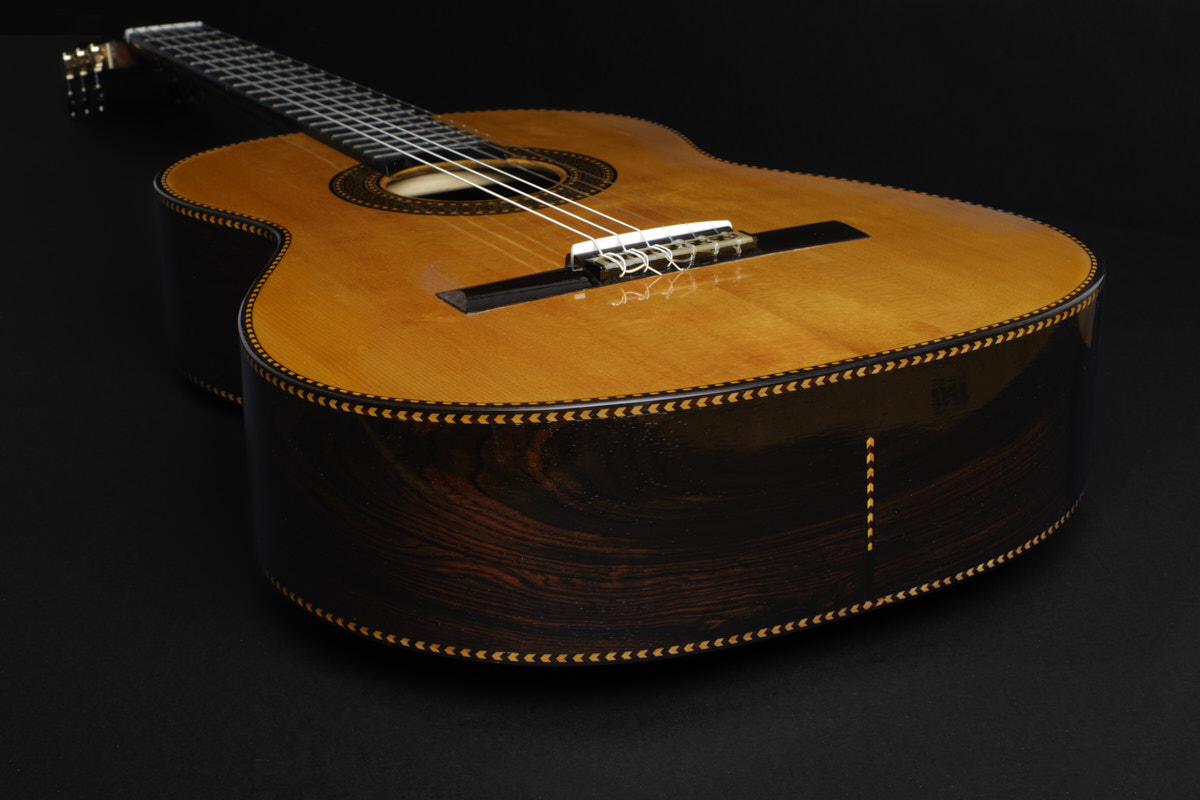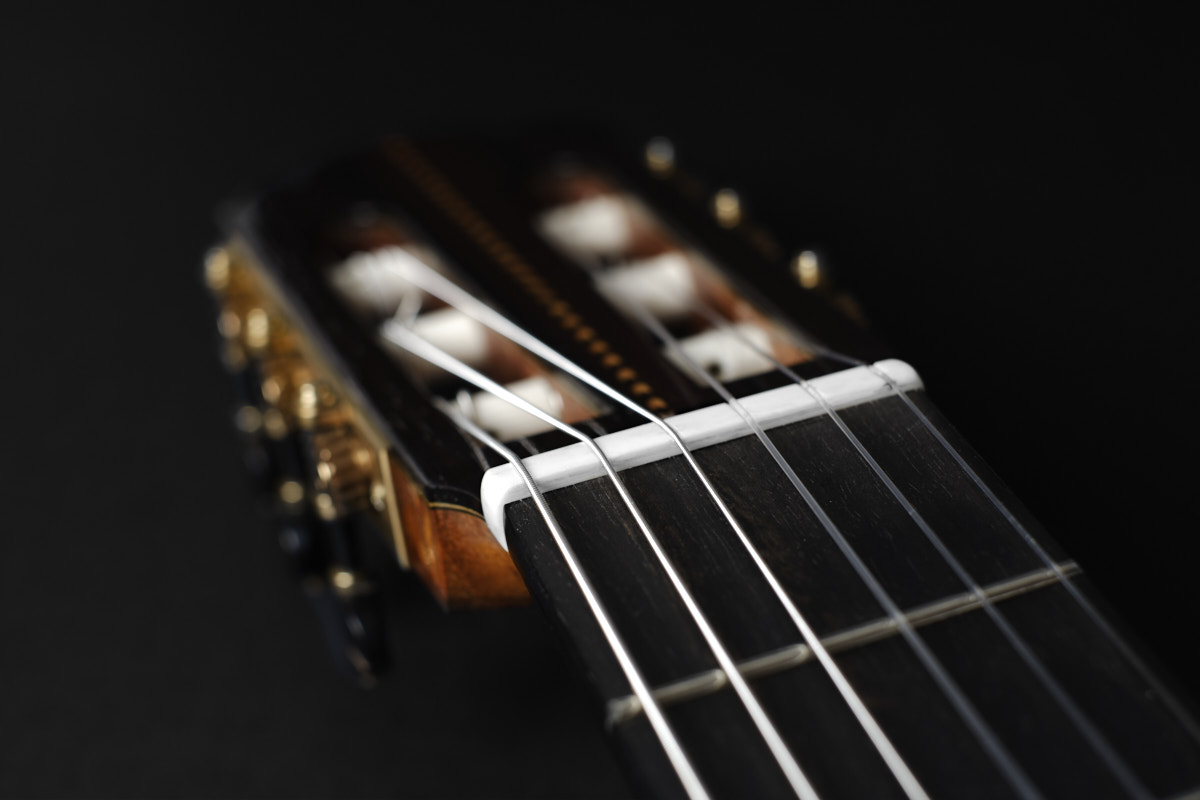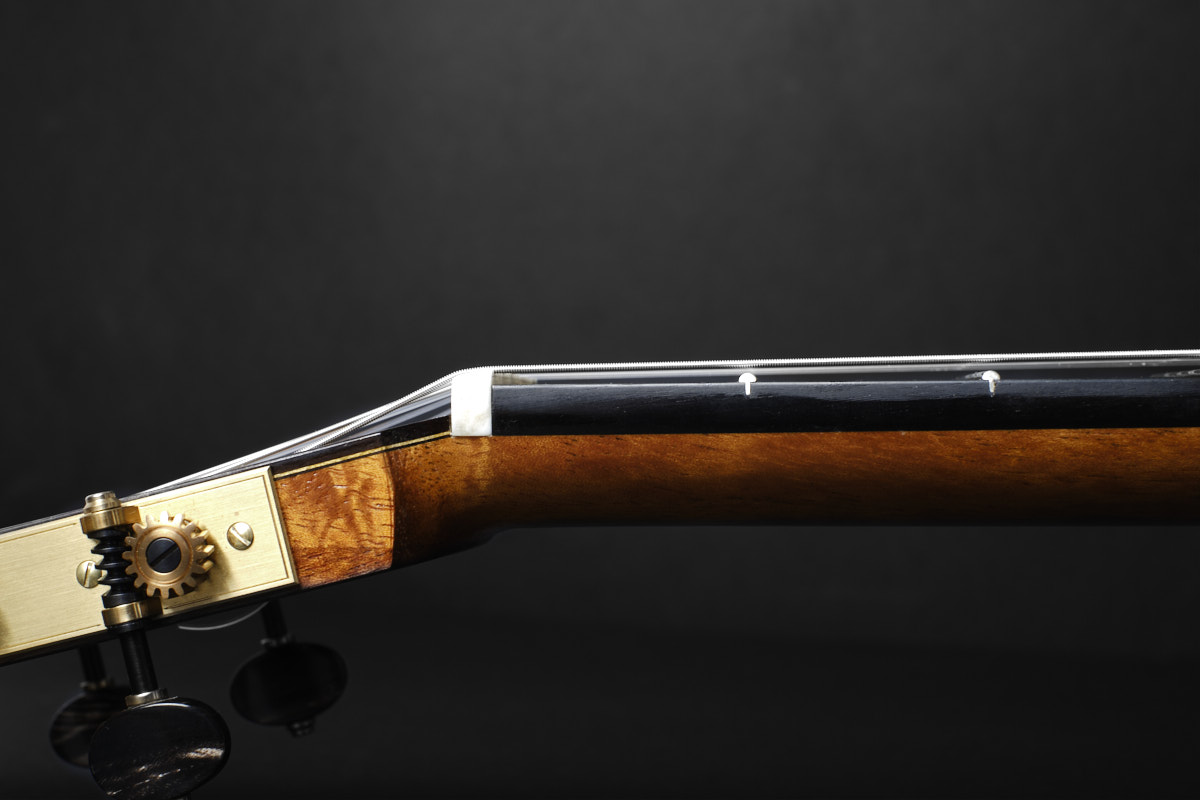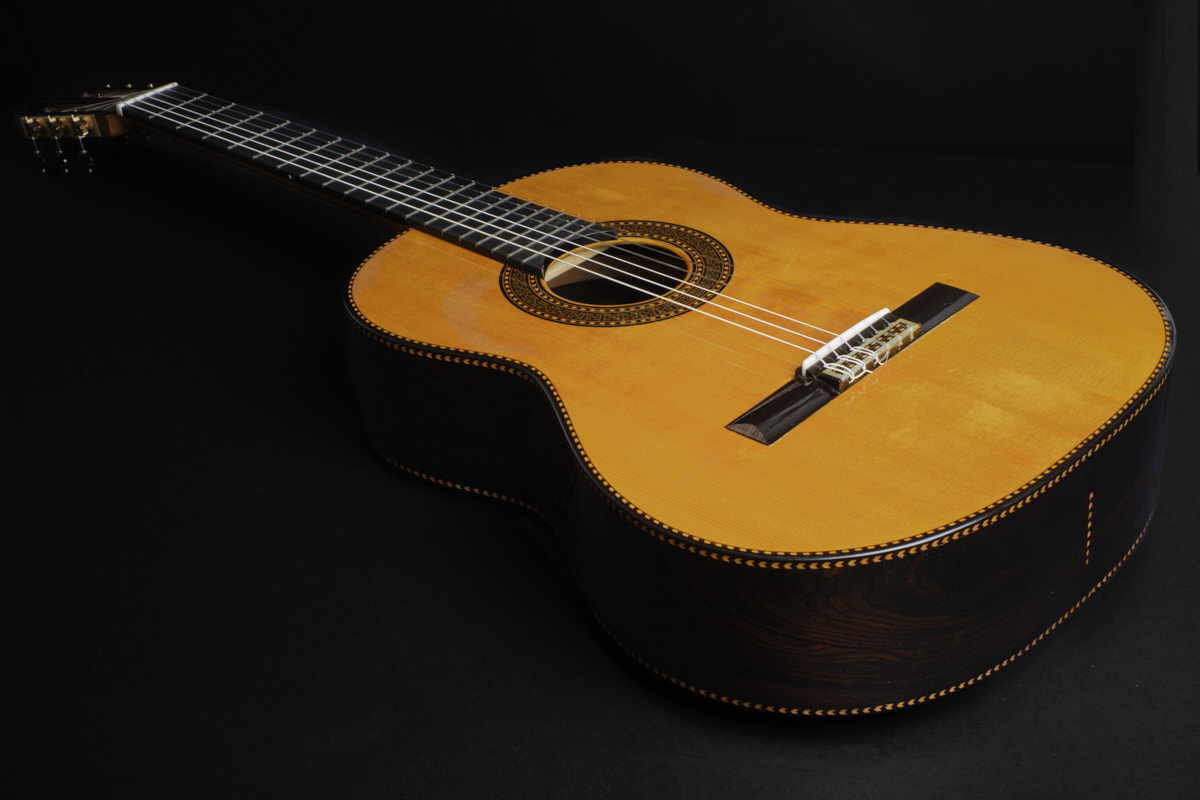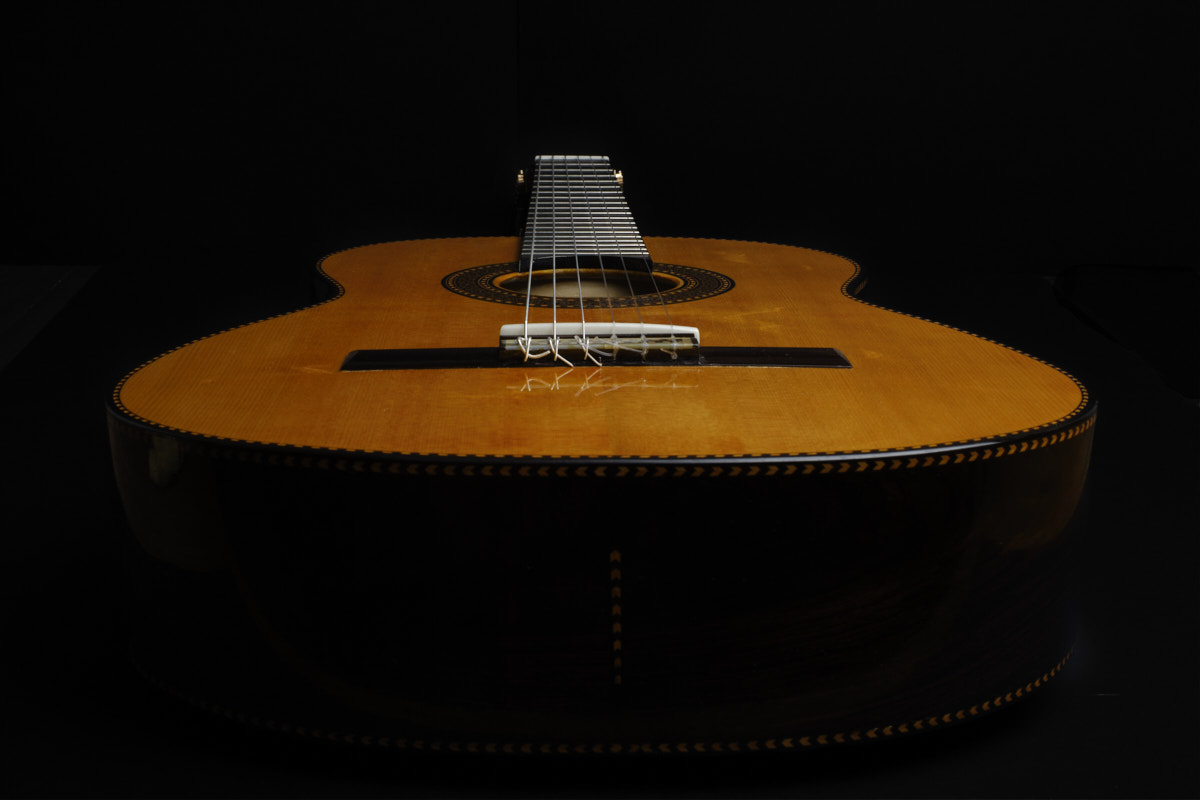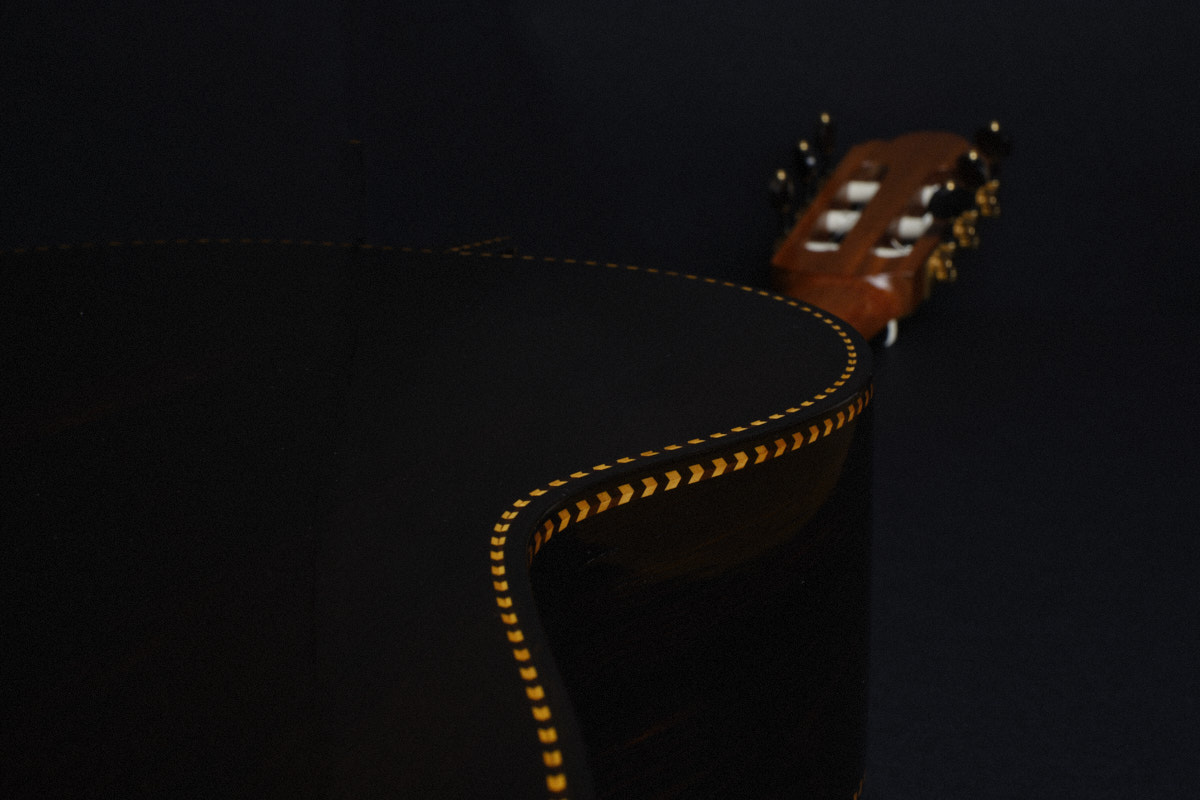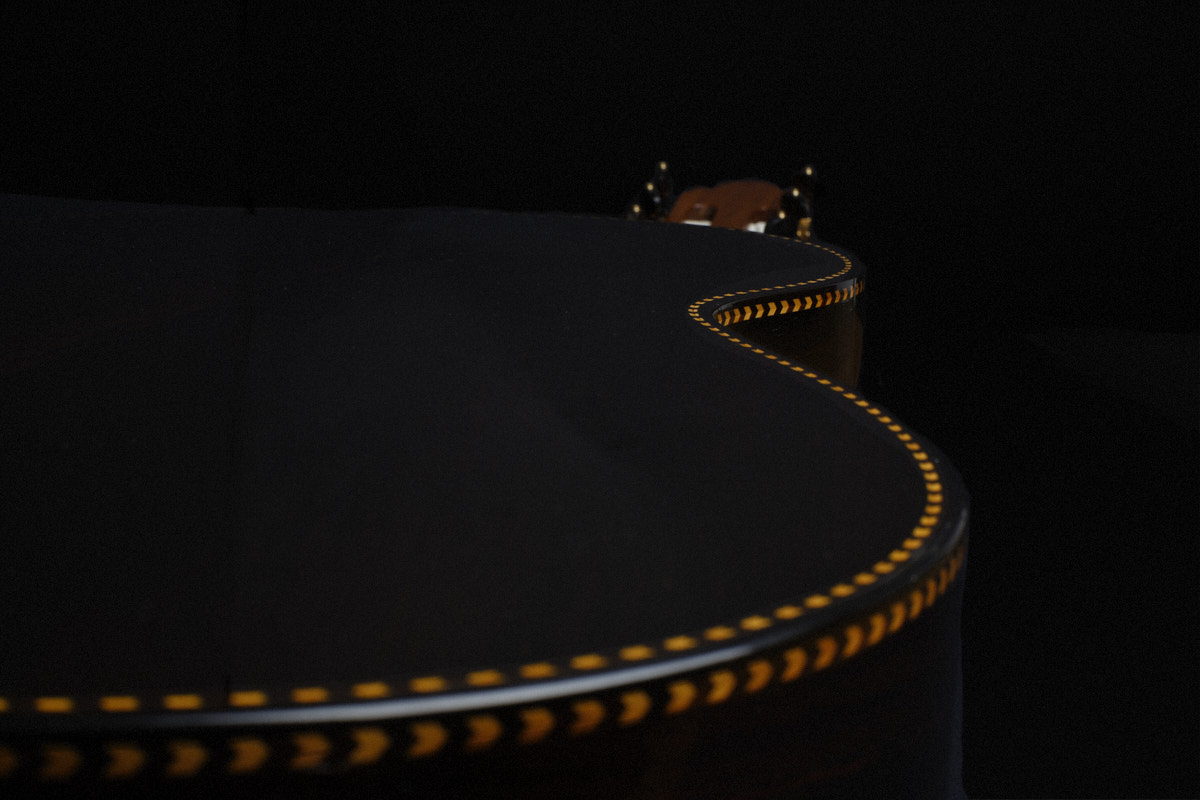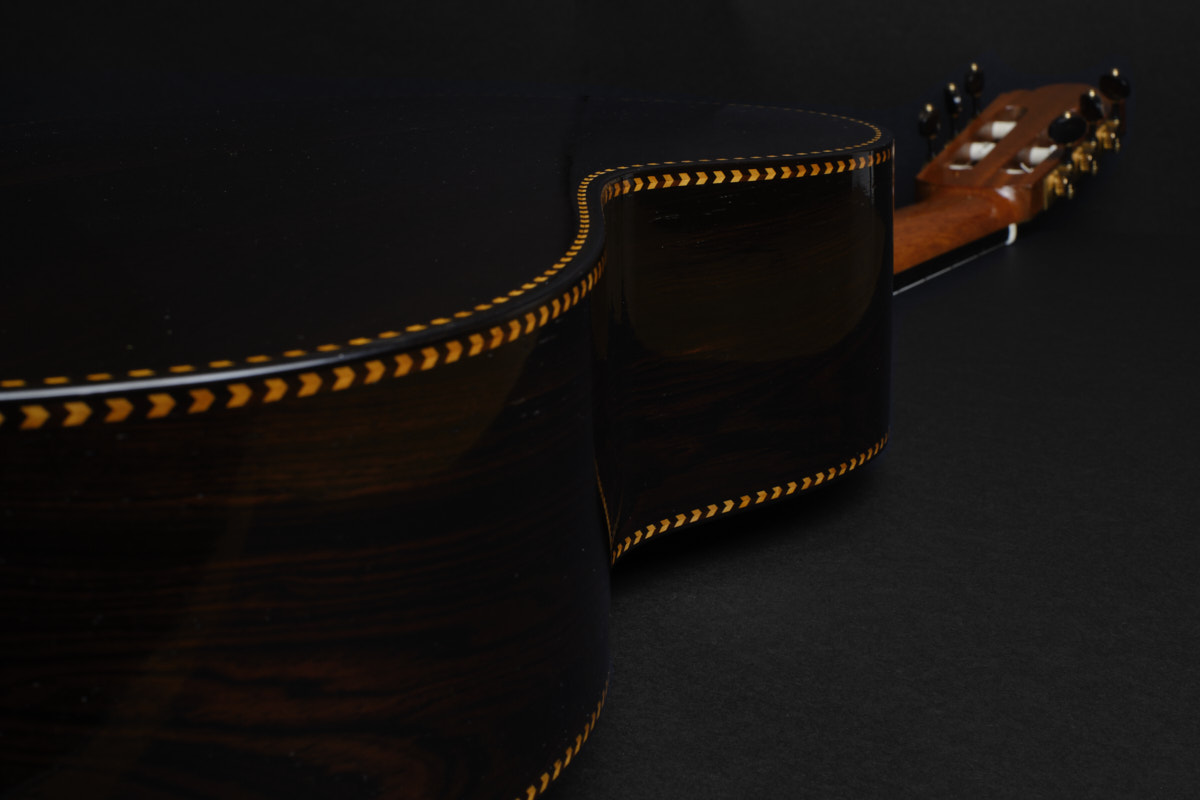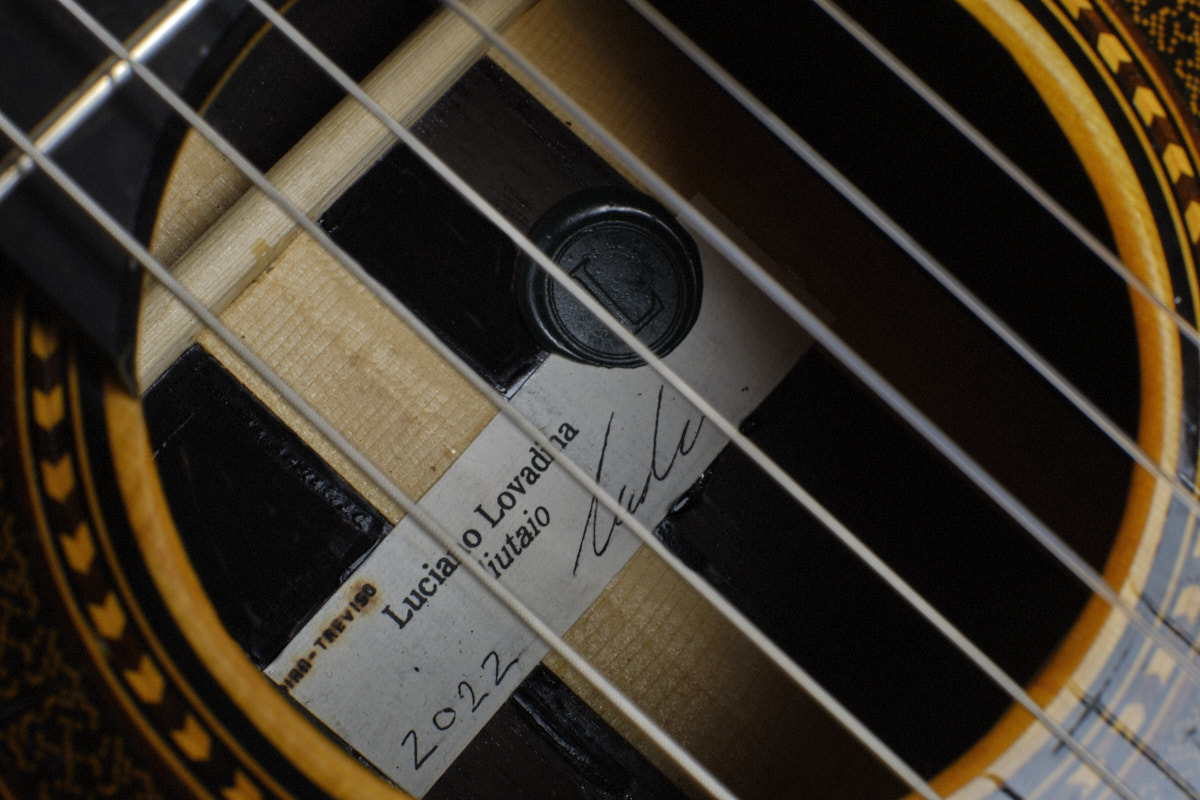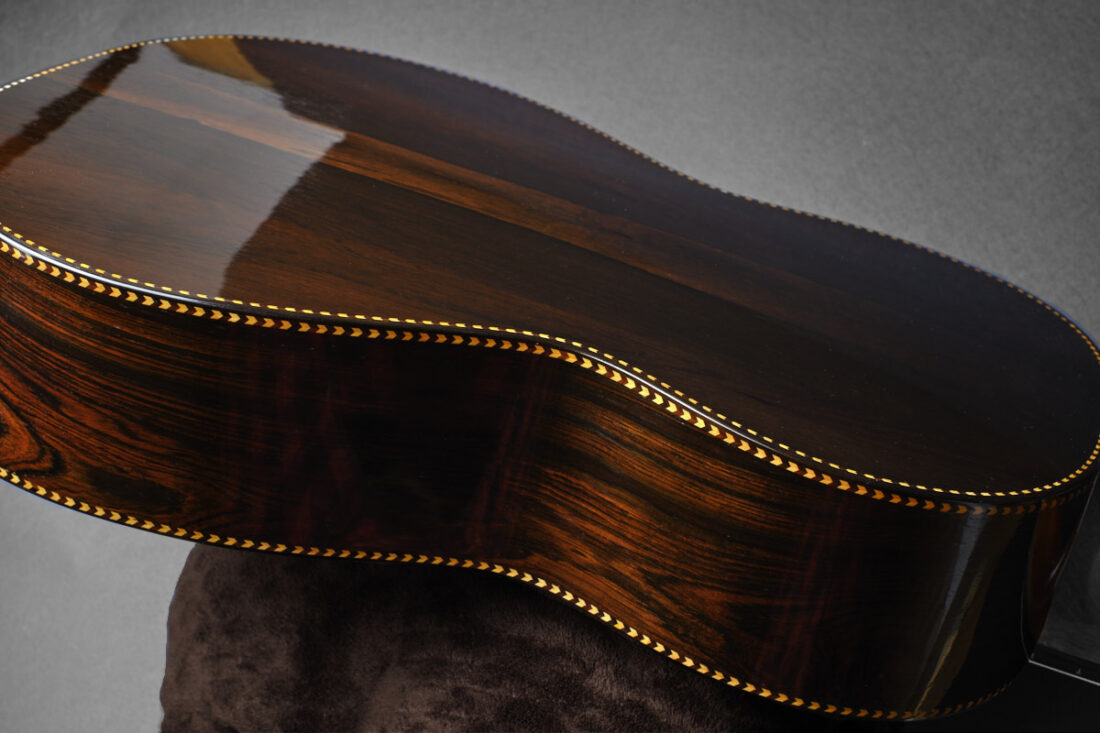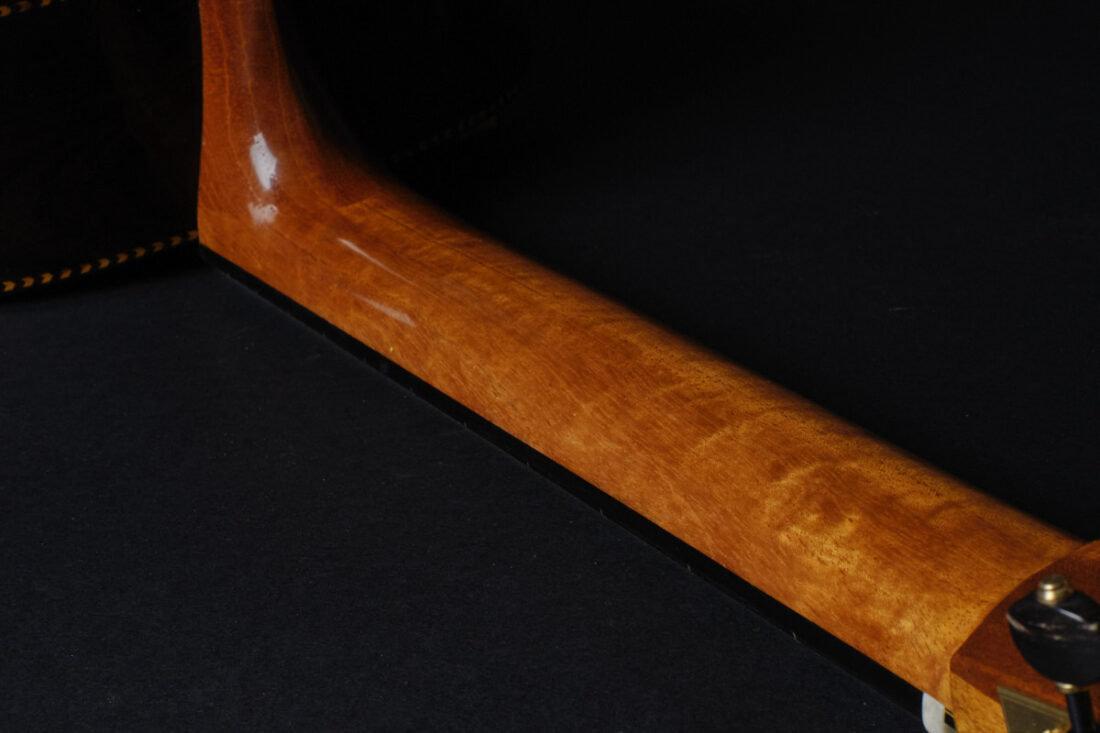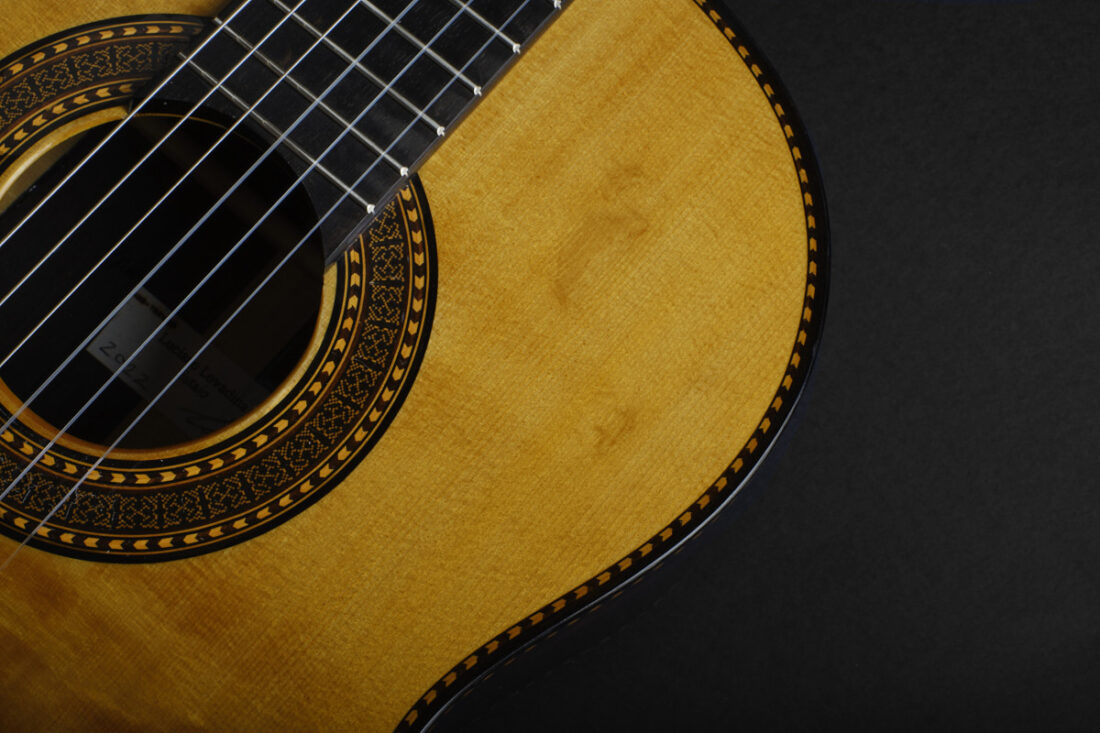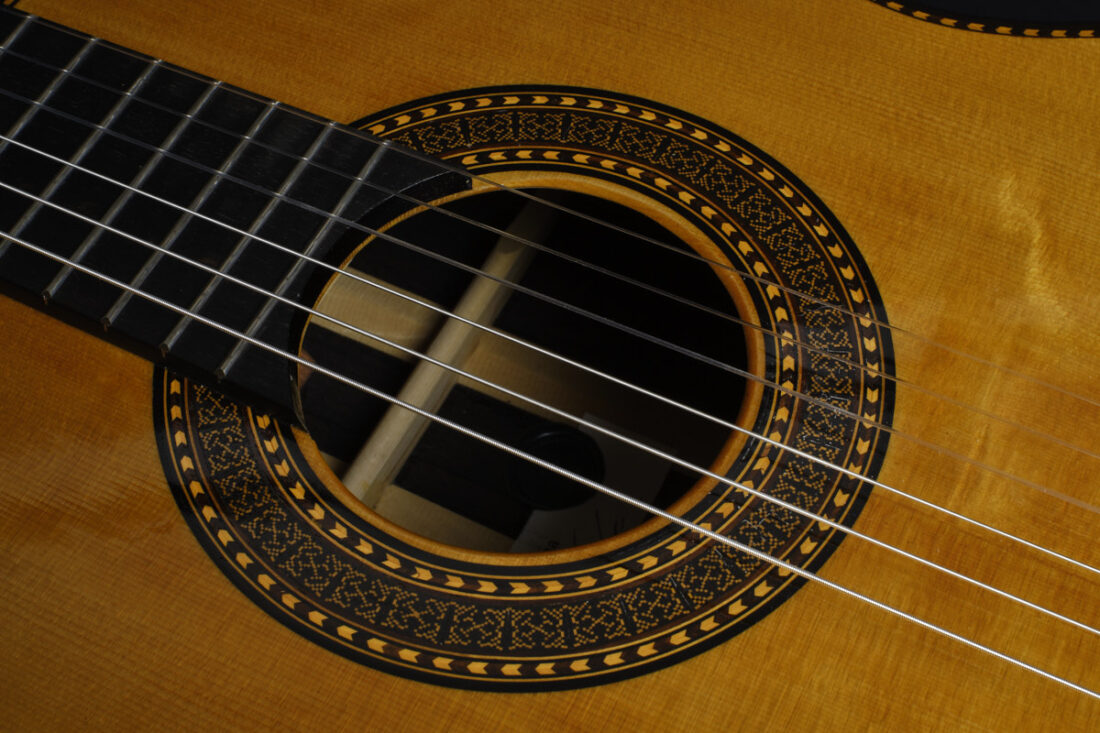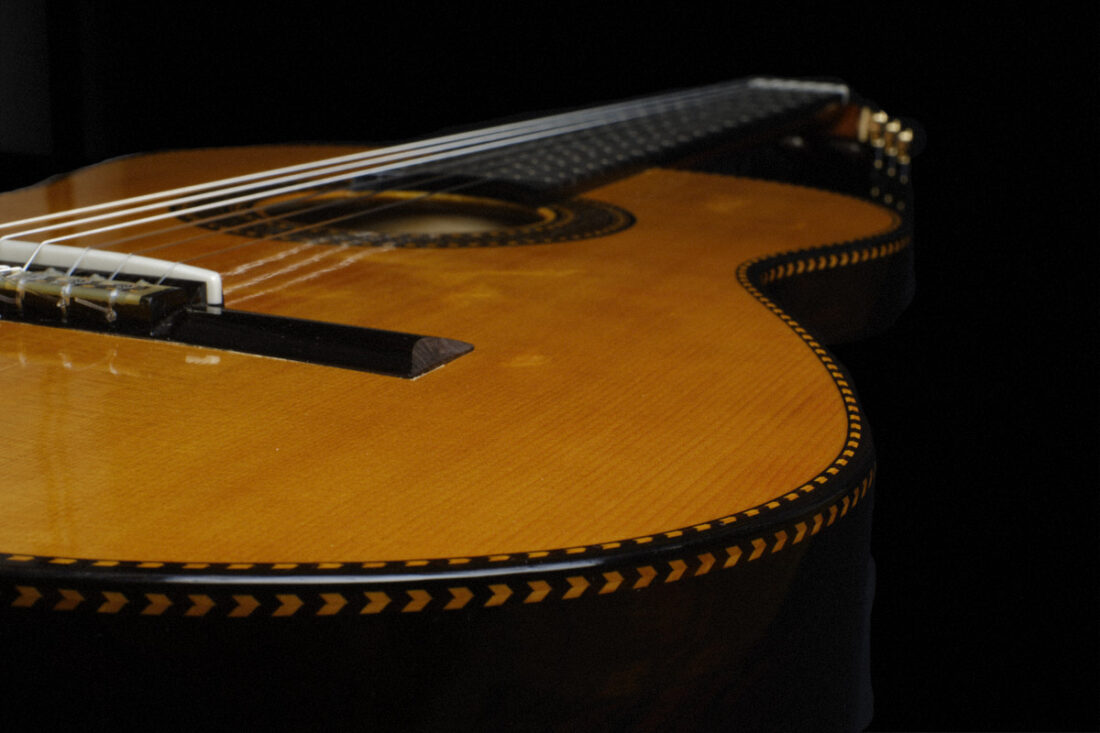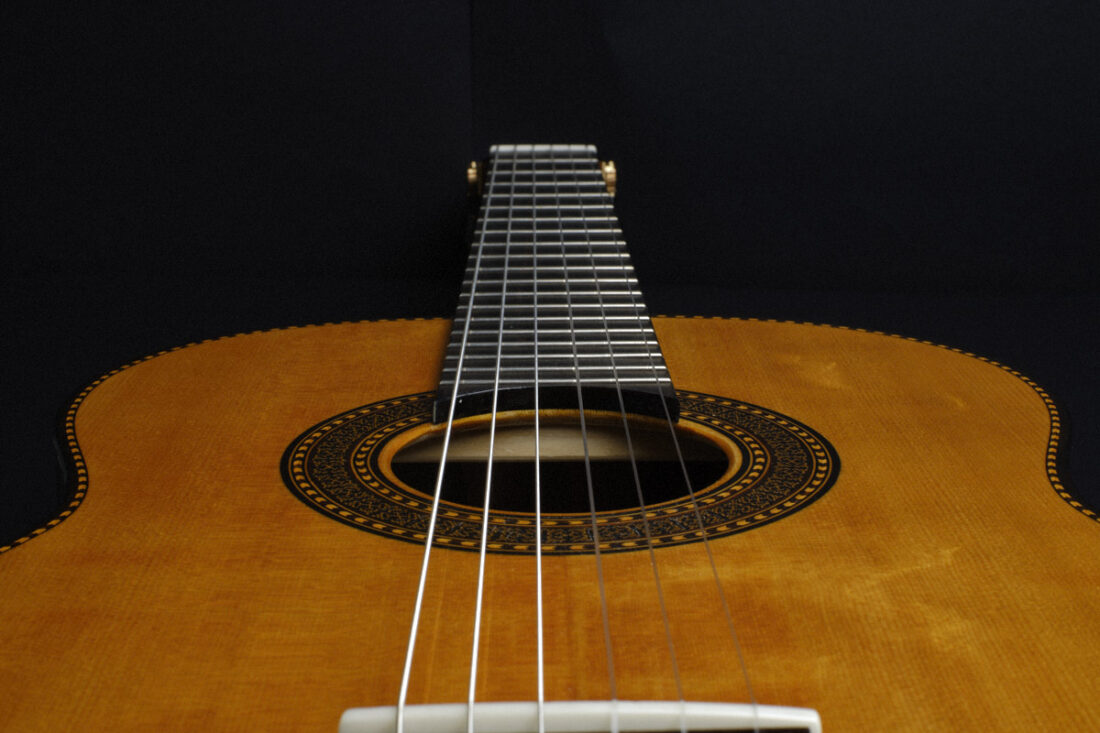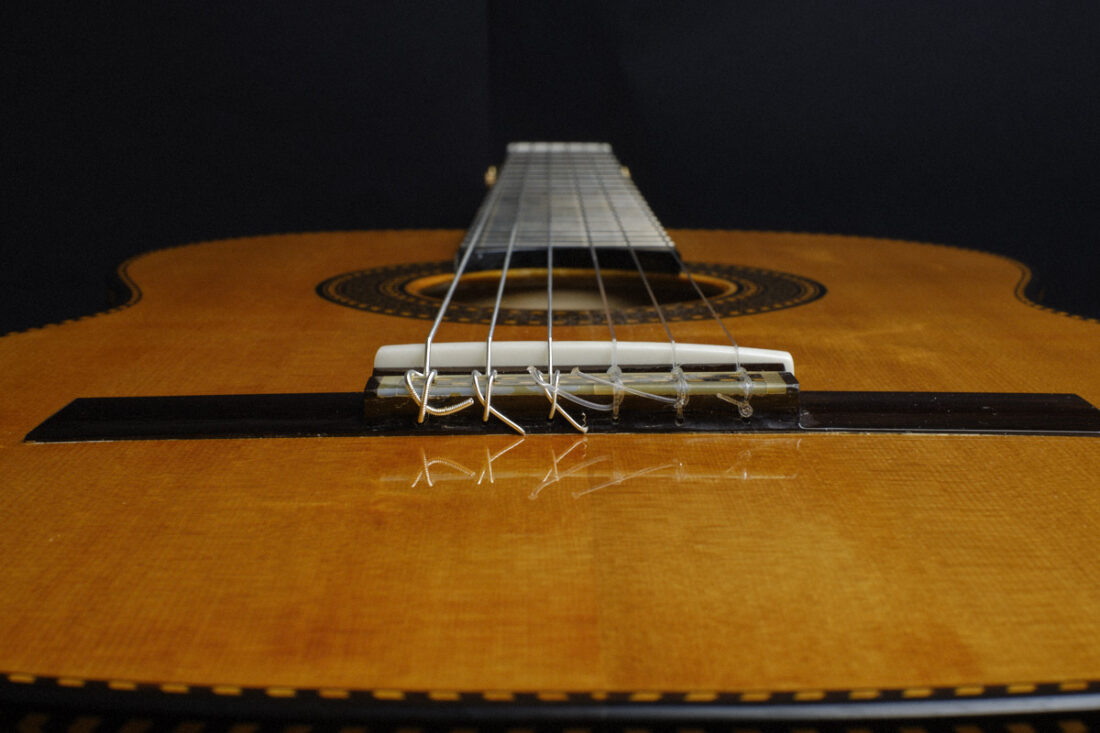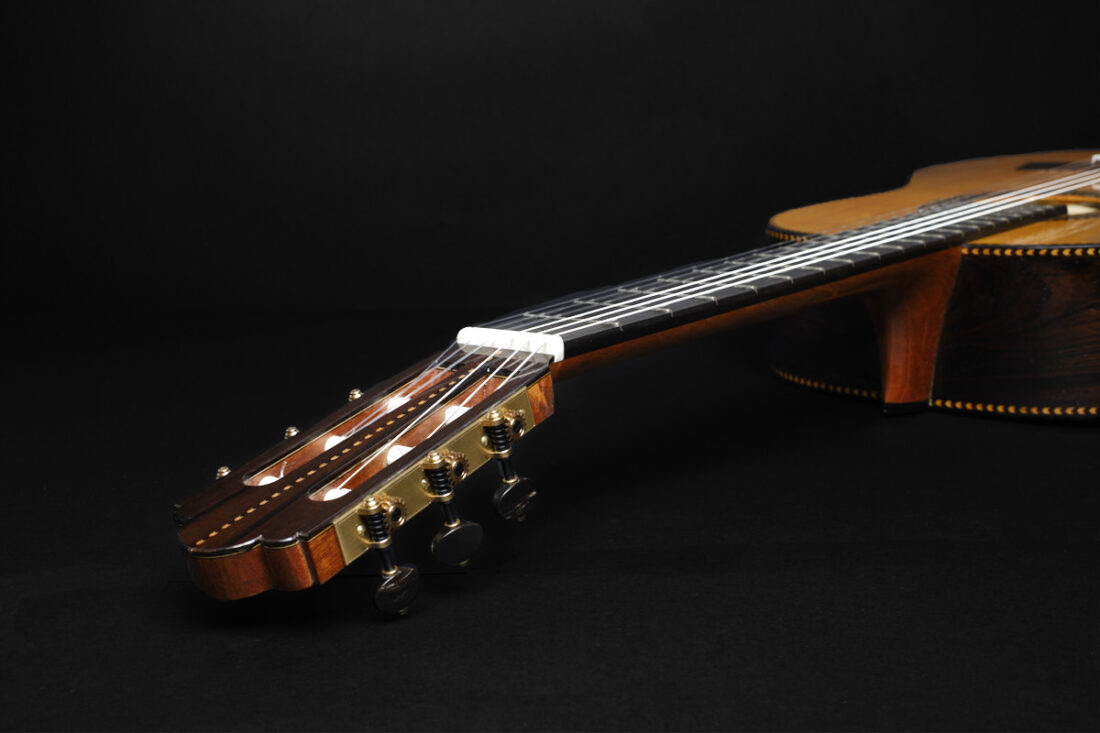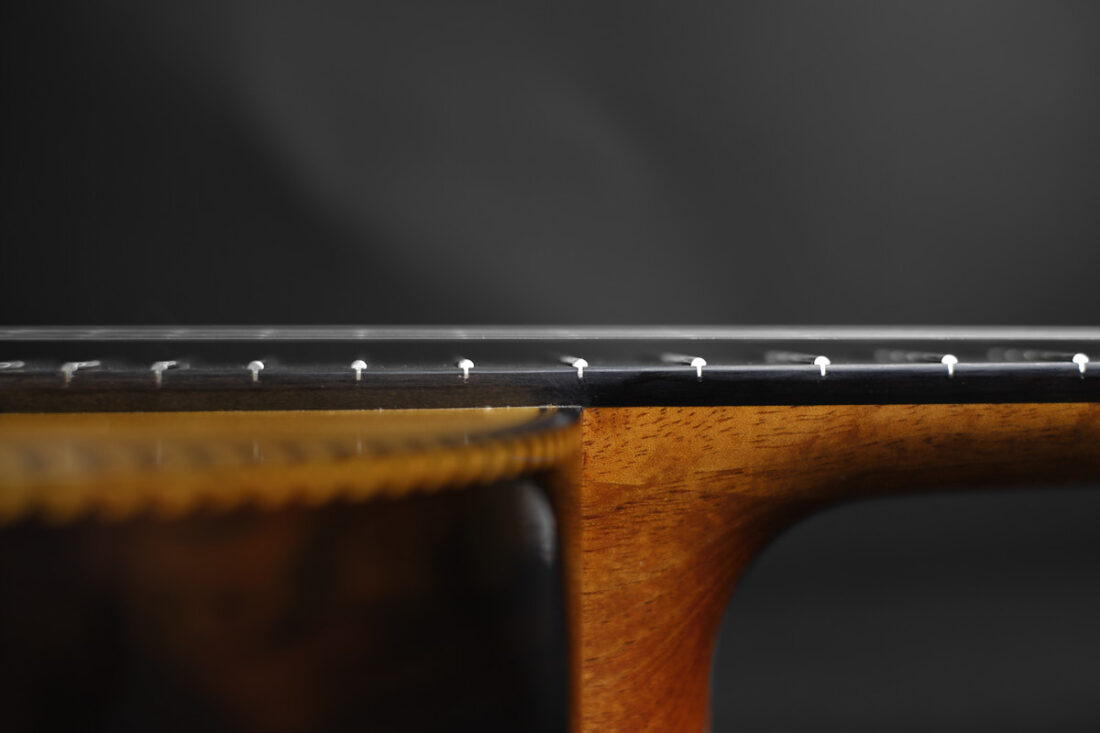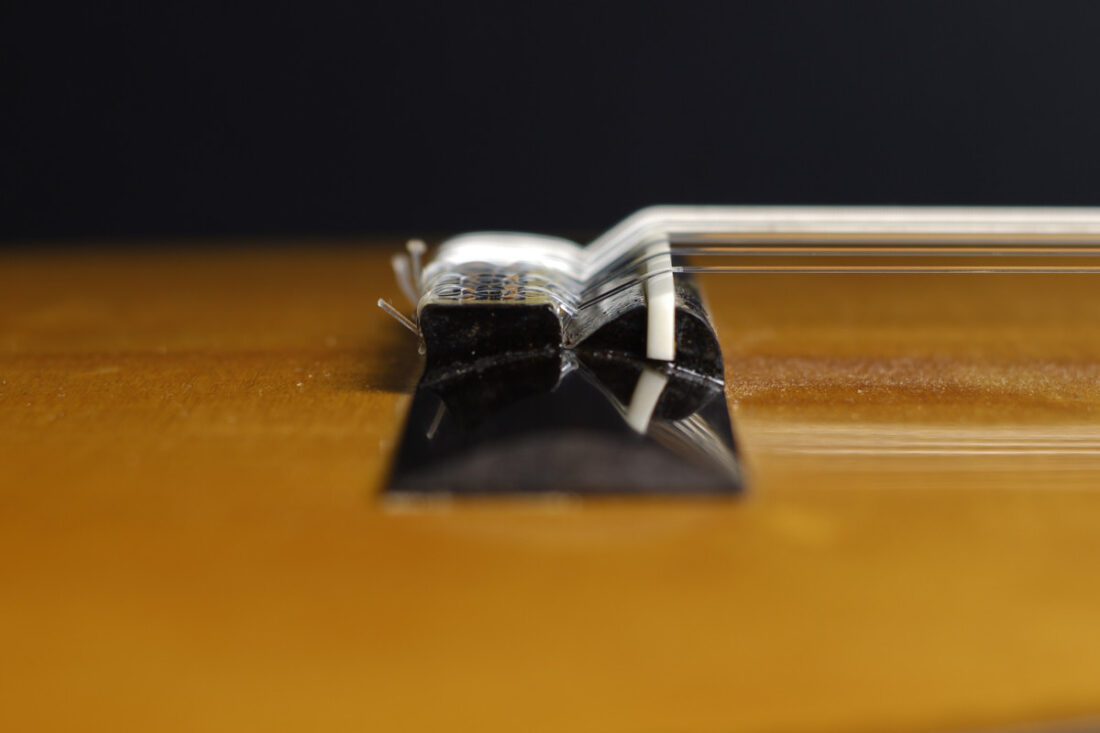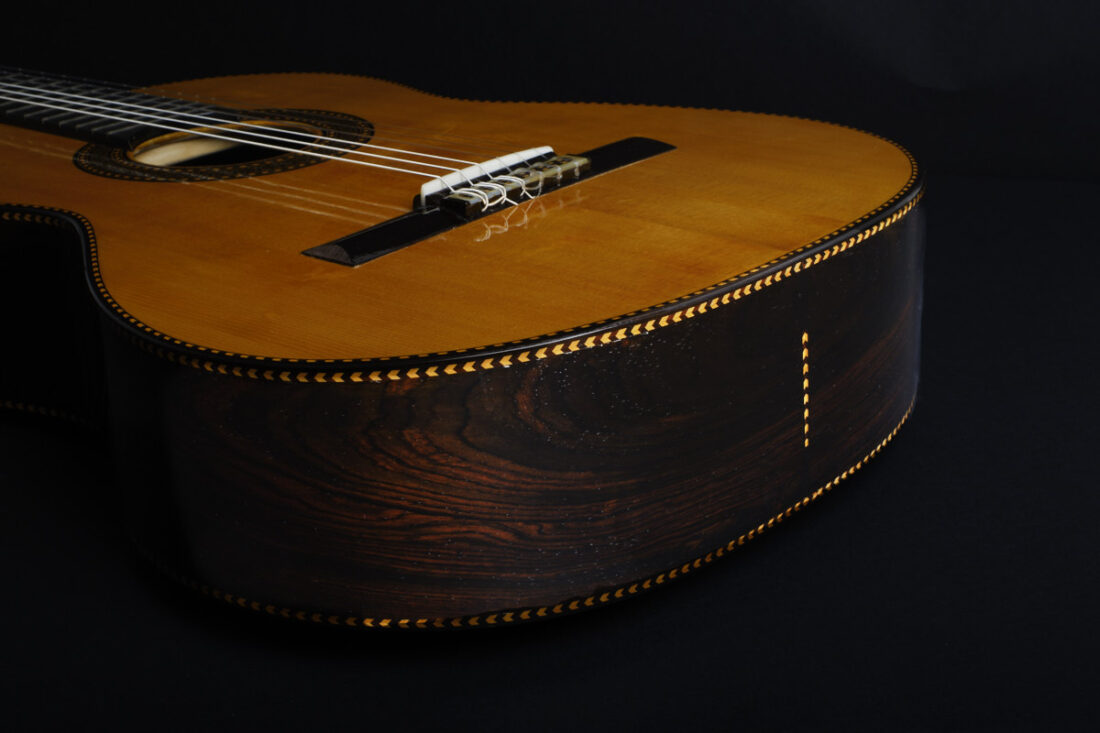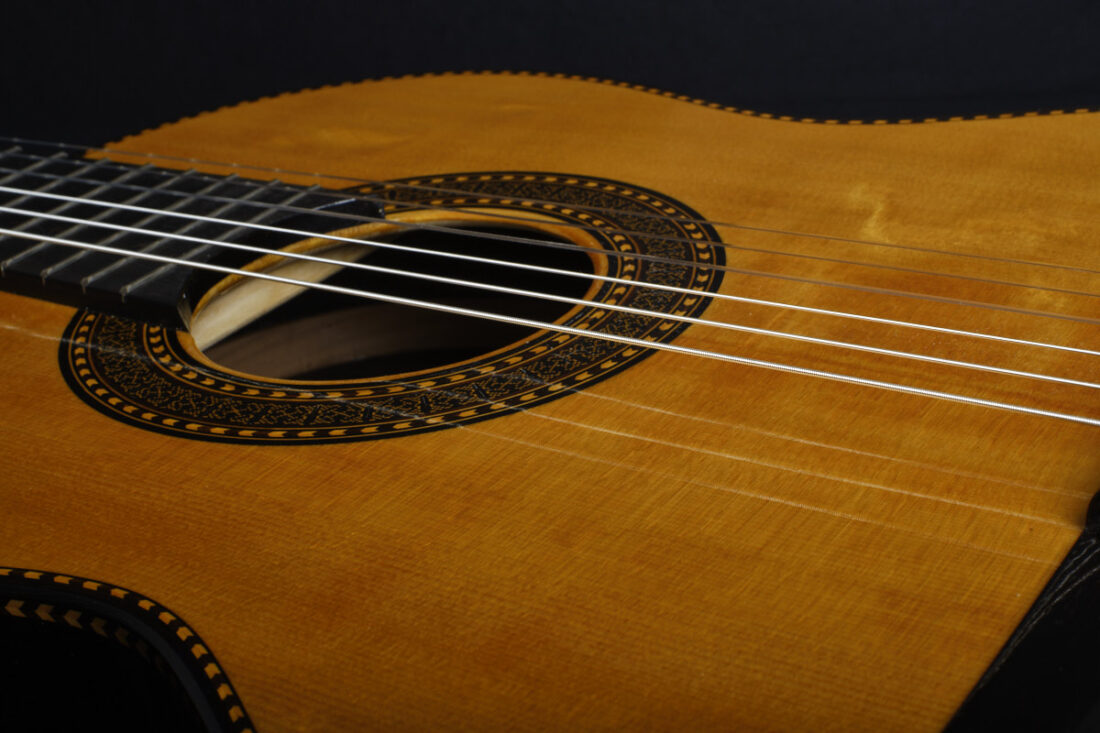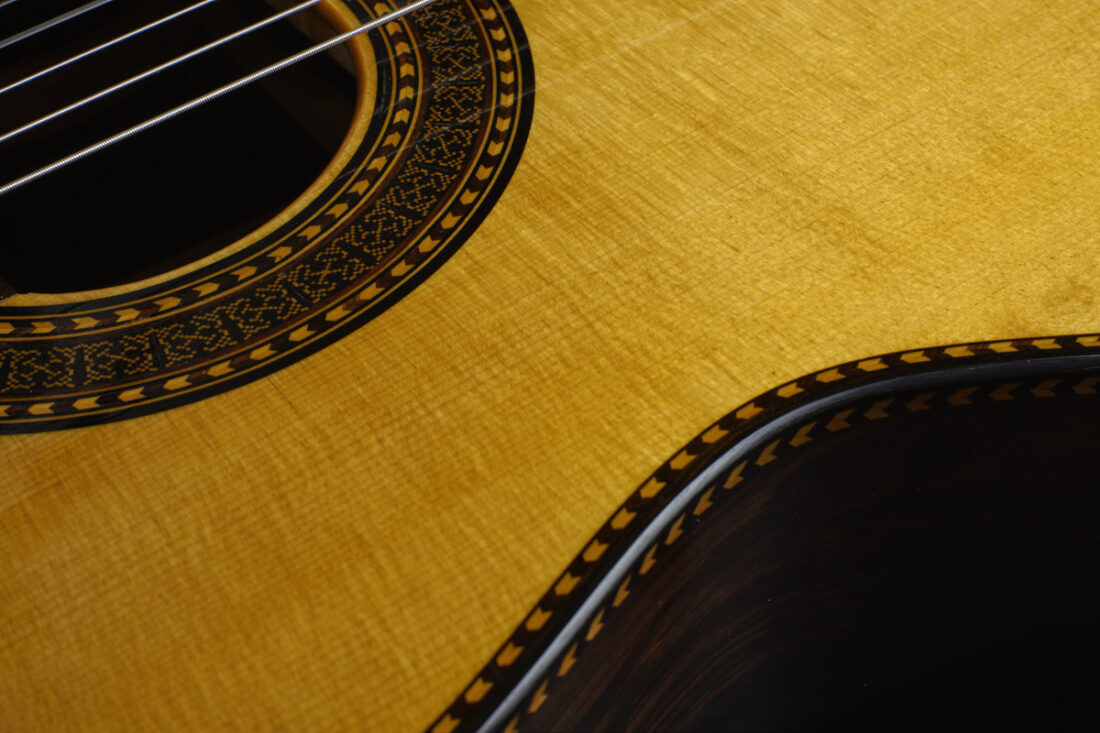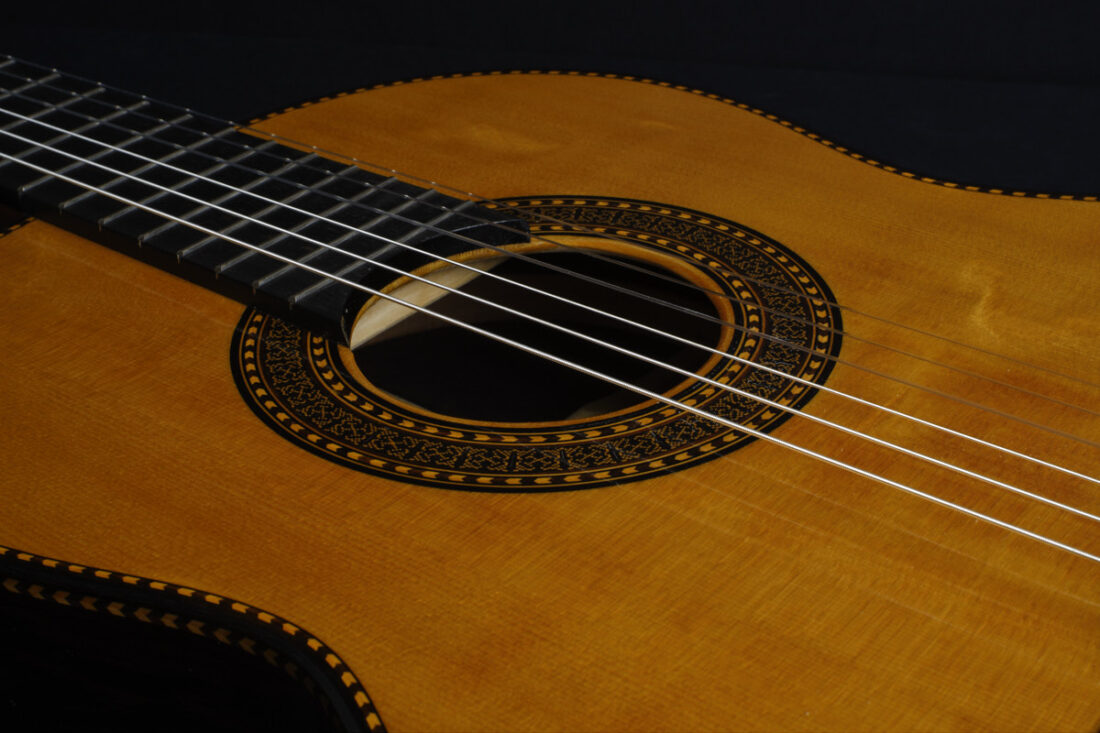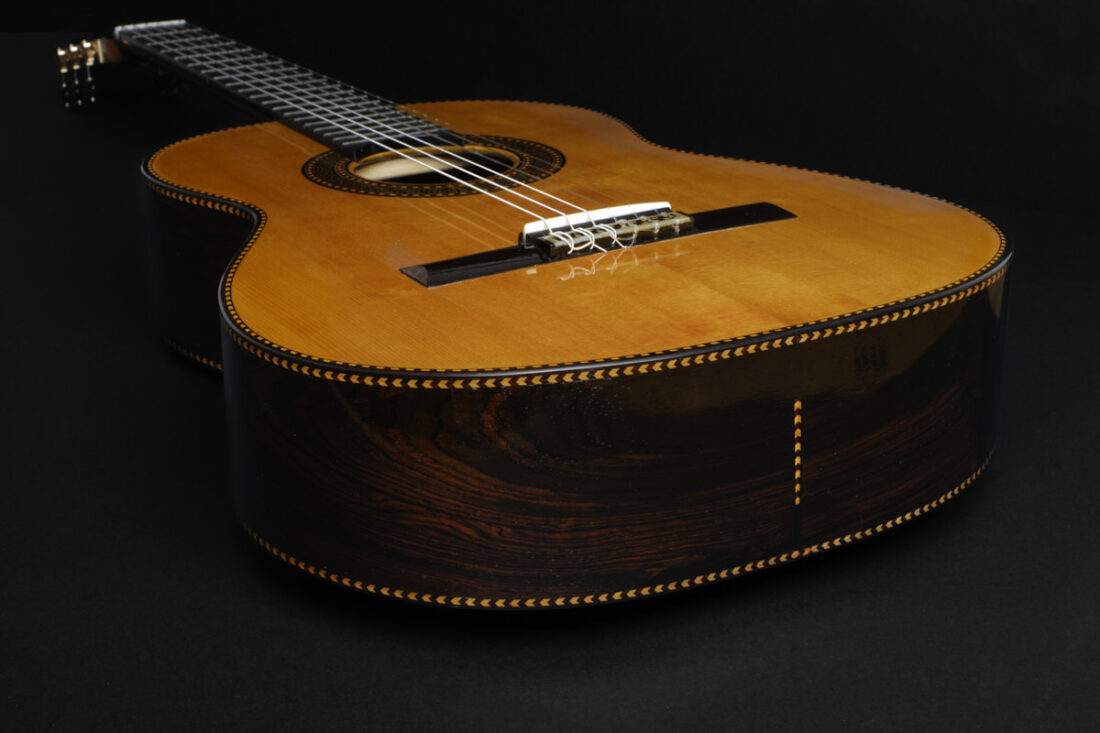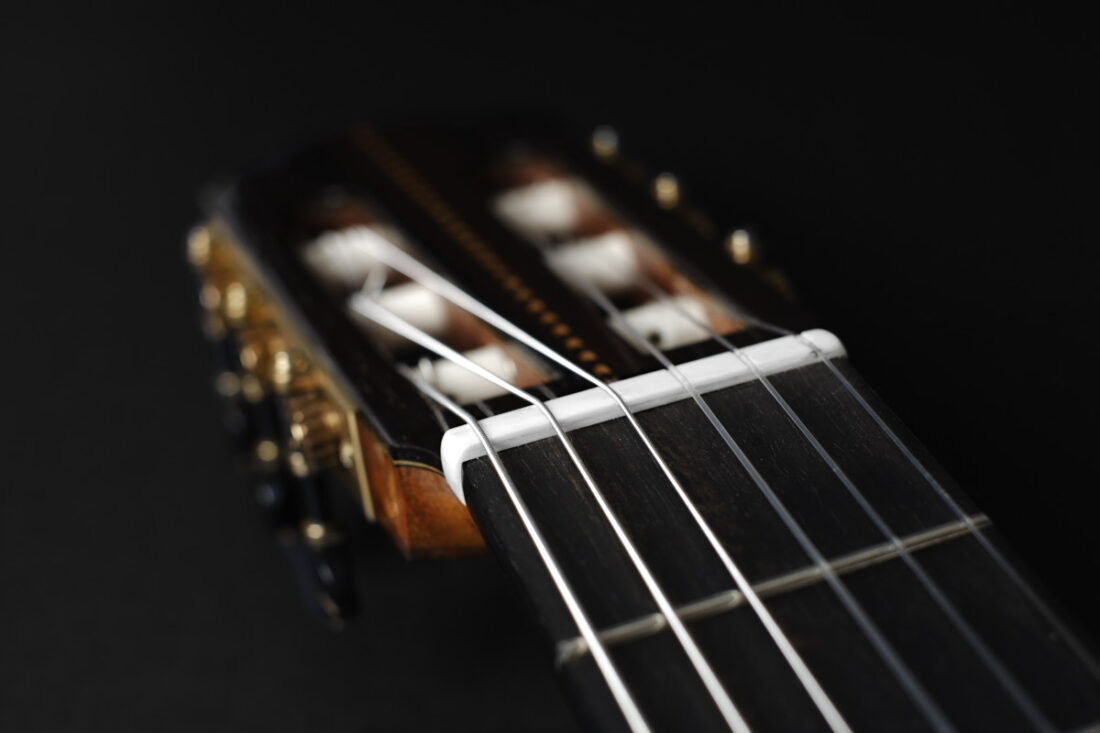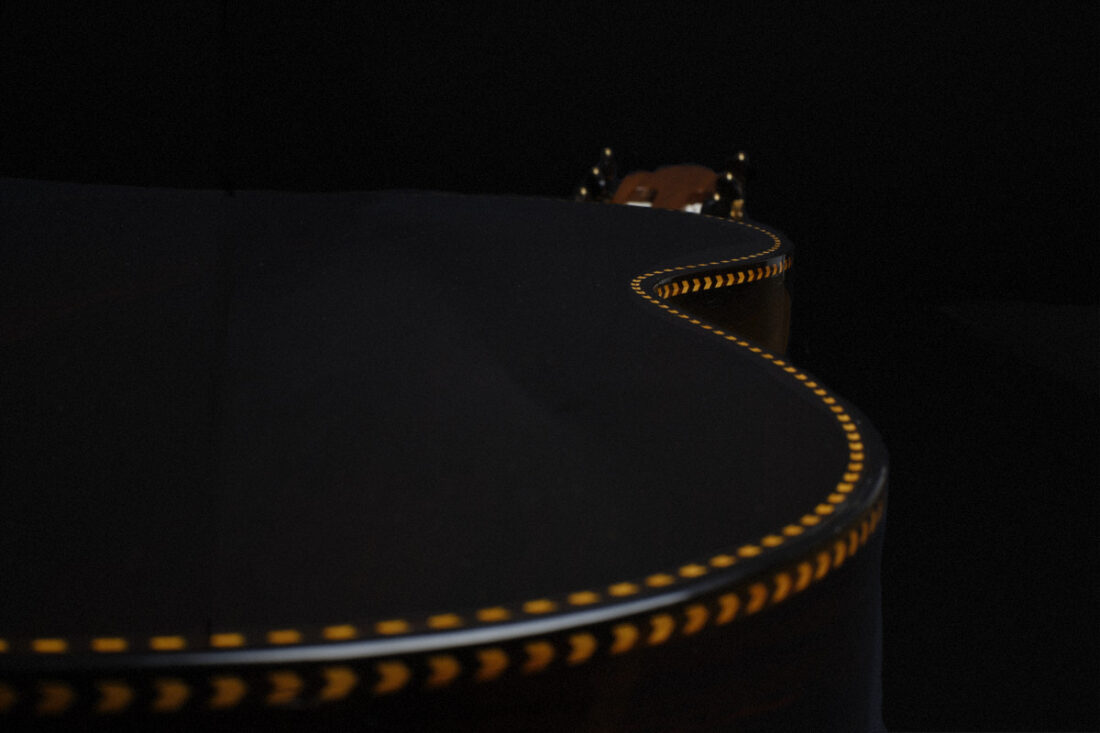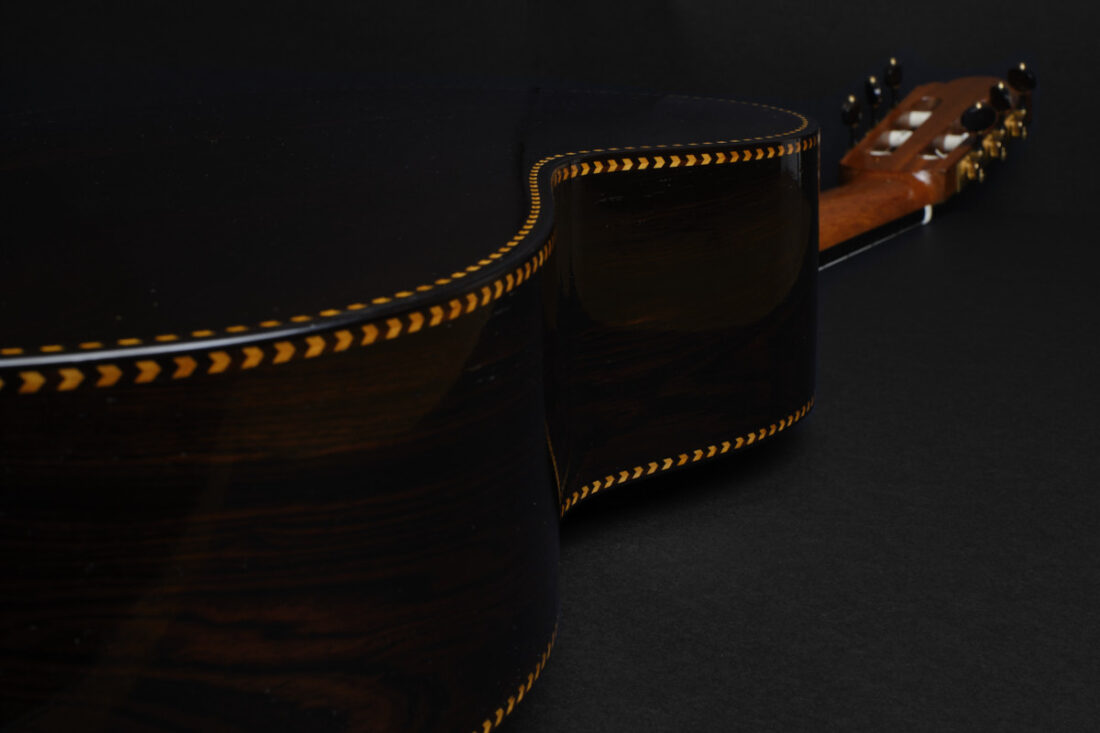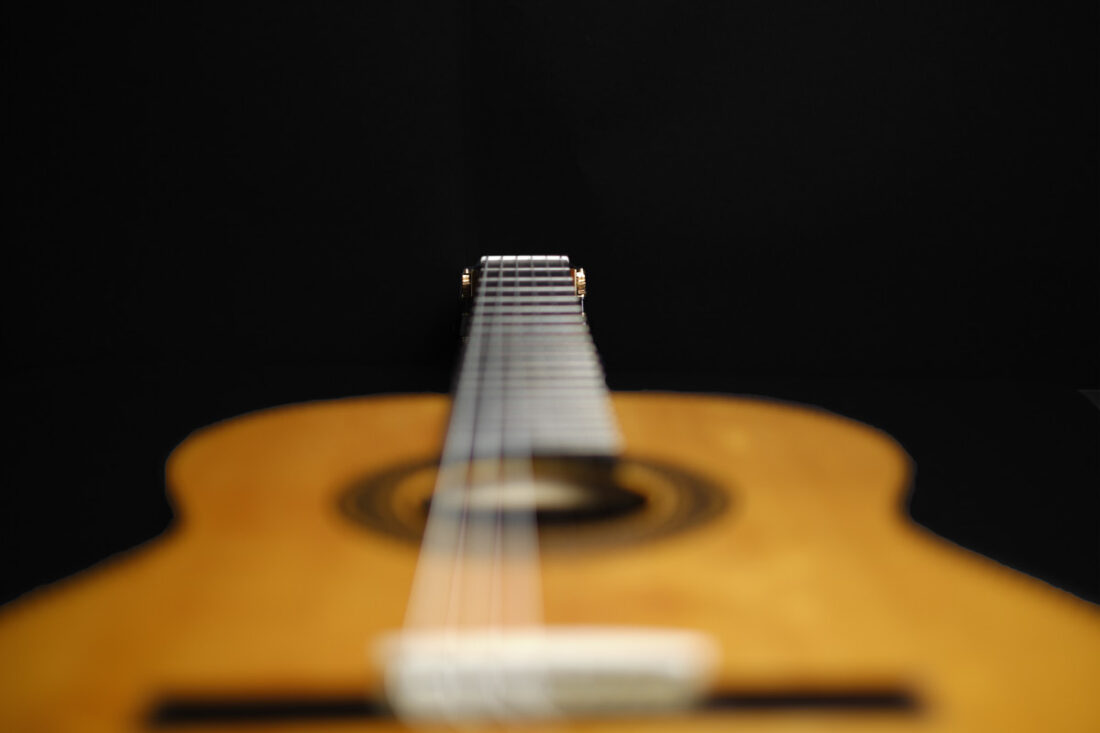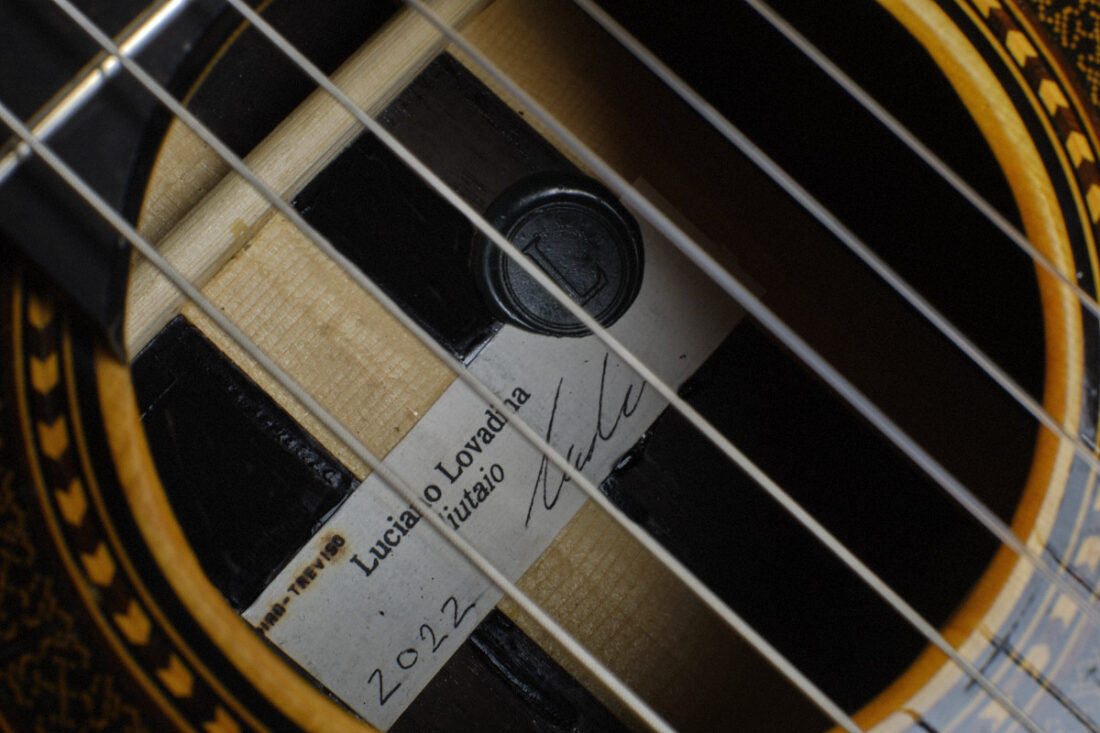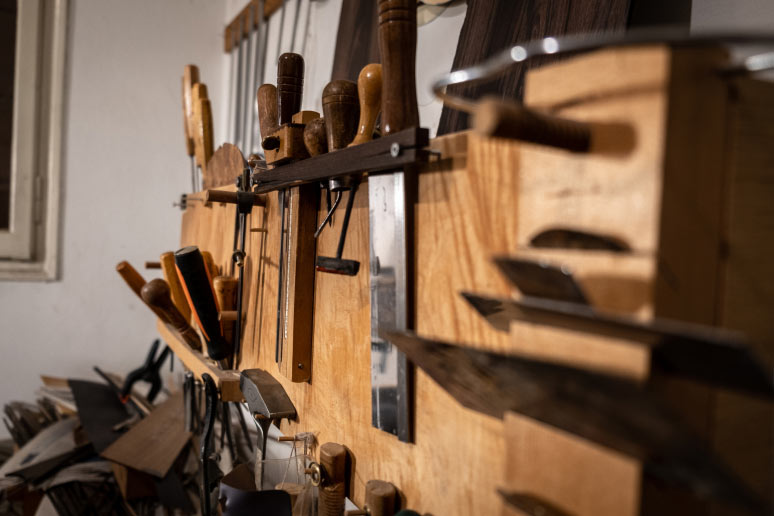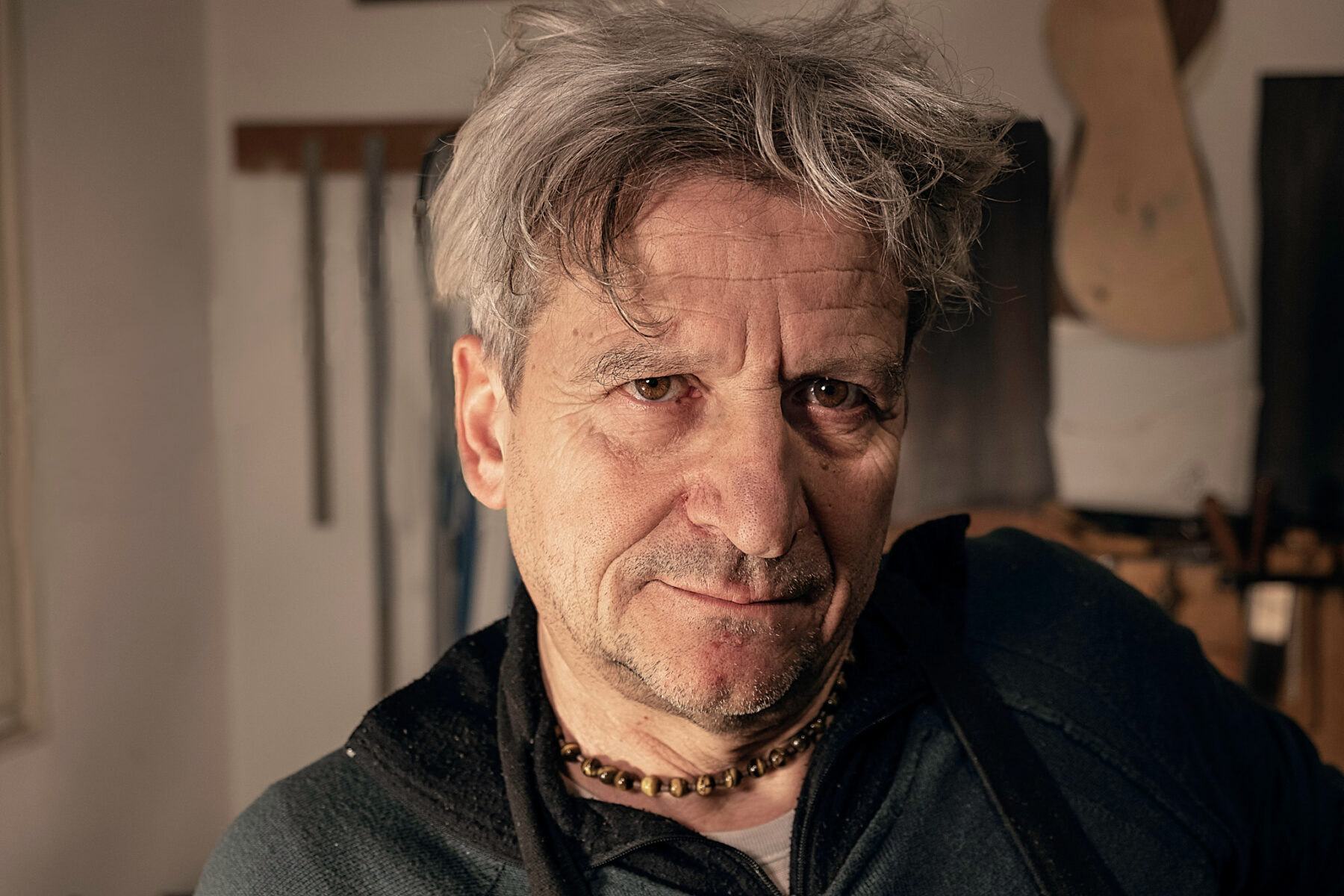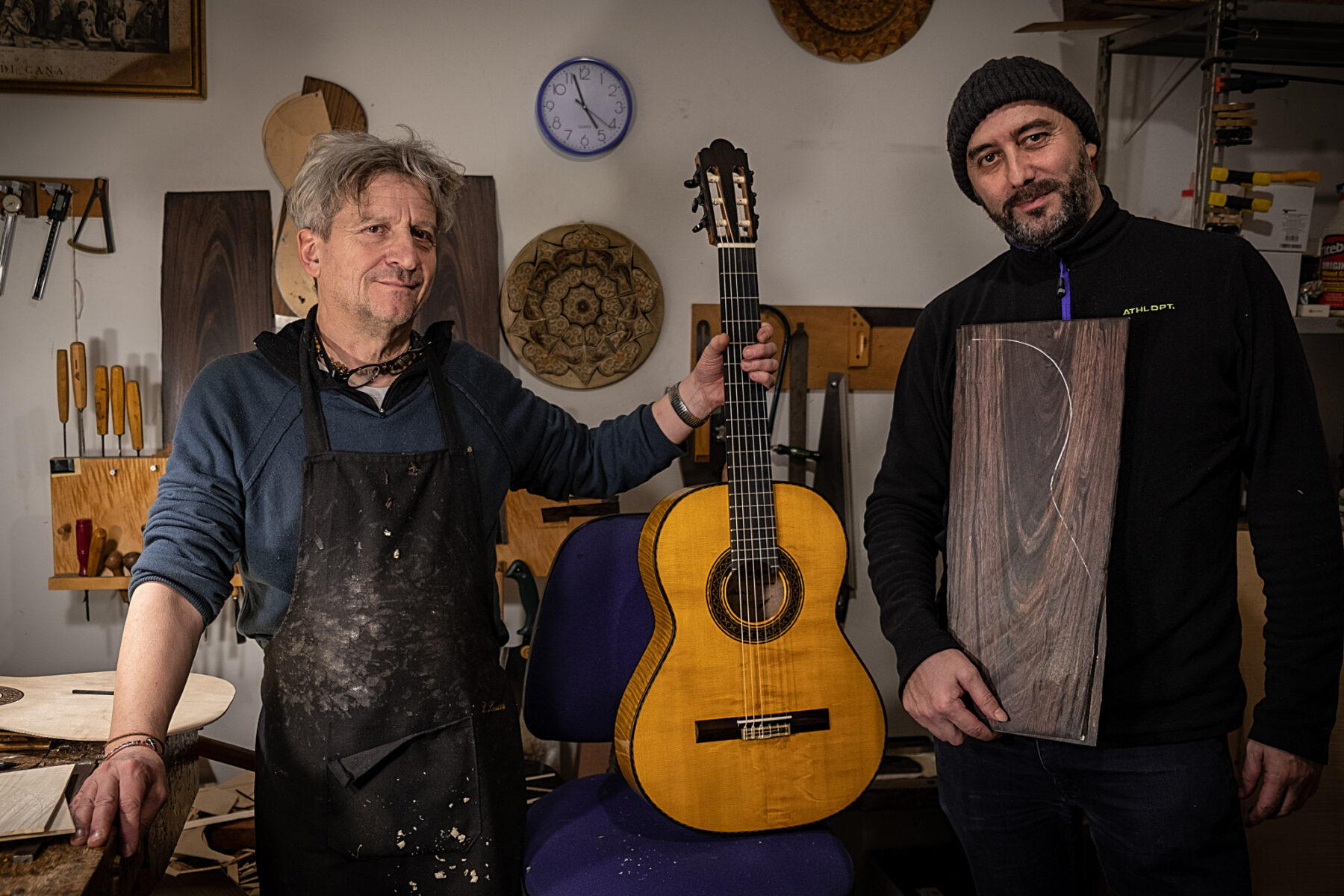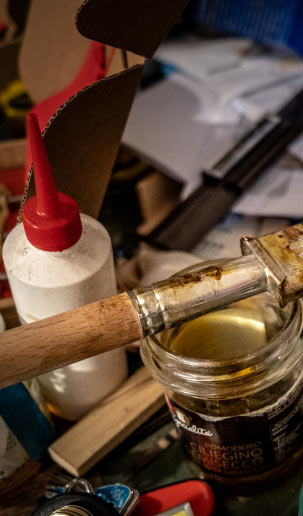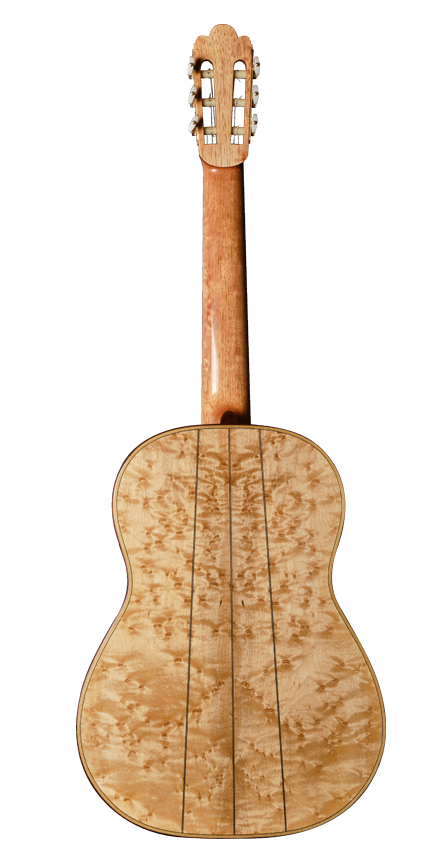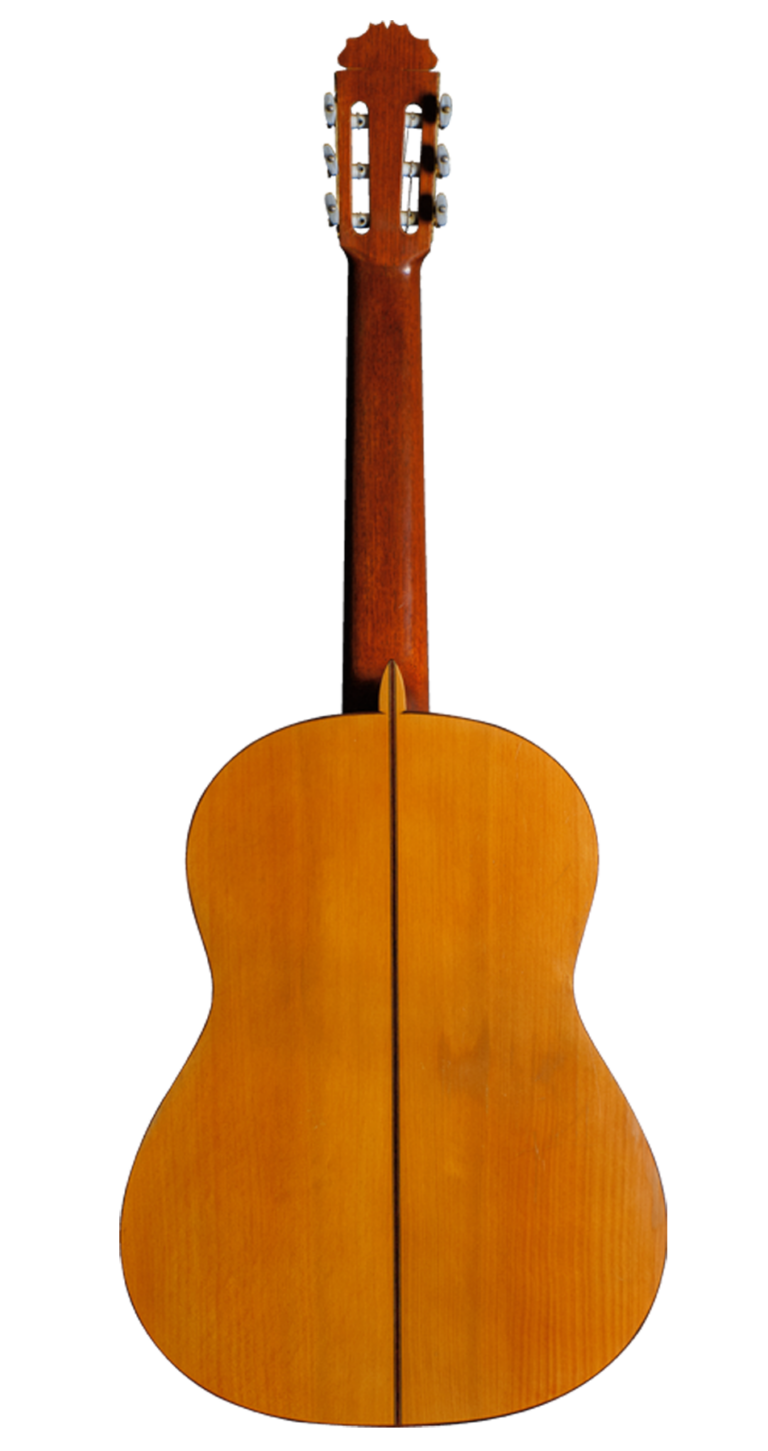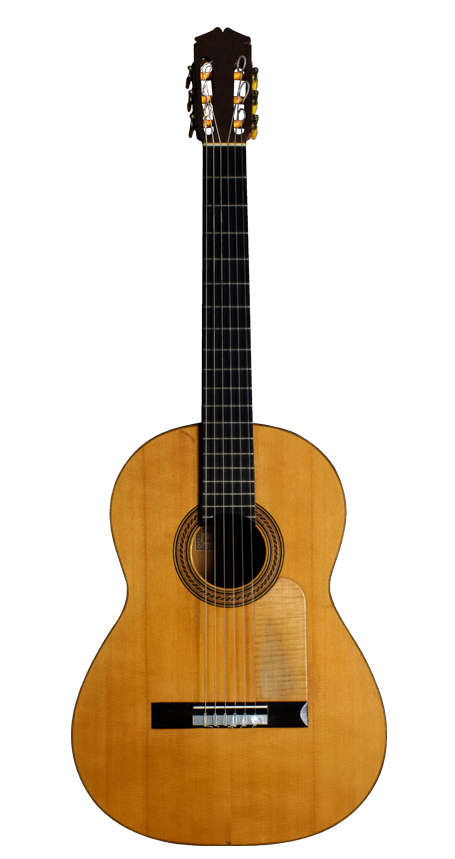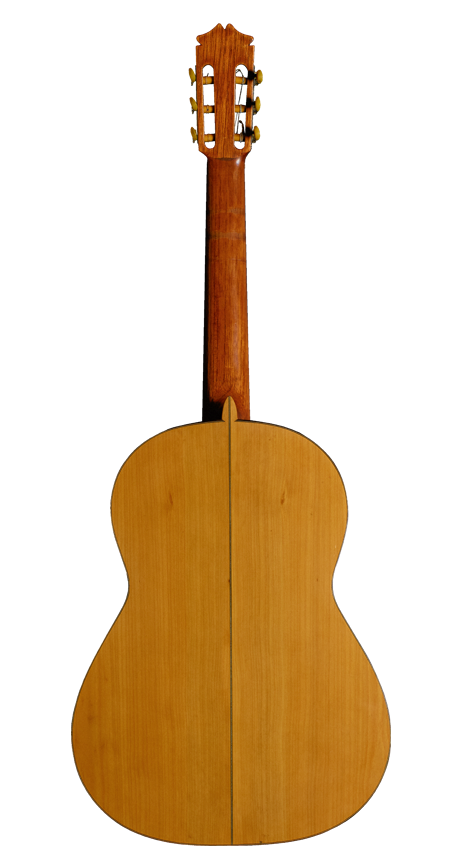Luciano Lovadina 2022
Construction: Classical Guitar
Top Wood: Spruce
Back and Sides Wood: CSA Rosewood
DESCRIPTION
Biography

DESCRIPTION
Biography
It was in 2018 when my friend the professional classical guitarist Morgan Szymanski called me at my home, which at that time was in Vicenza, Italy, to tell me that he was on a concert tour in the north of Italy and that apart from seeing us he wanted me to meet a guitar maker he called “special” who worked in the area. It was the classical guitar maker who has made his classical guitar with which he has been giving concerts all over the world for more than 4 years now.
I was delighted to see my friend again and to meet this guitar maker who was “special”. So there I was the following days in Luciano Lovadina’s workshop where he spends so many hours every day and where he makes his guitars.
My first reaction when I saw his guitar was a little bit of not placing it. I was used to seeing classical guitars of all kinds of traditional Spanish construction and also classical guitars of modern construction made of Nomex, Lattice, double top … And those two types of guitars were the ones that on one side or the other could describe practically all the classical guitars on the market today.
Also living in Italy what I found most were guitars based on traditional Spanish construction with a great presence of construction models and aesthetics of Spanish guitar makers such as Antonio de Torres or the Barcelona school such as Enrique García or Simplicio, who are also admired in Italy.
Luciano’s guitar was nowhere to be found. I couldn’t place it. In its aesthetic part it had an orangey, vintage colour, which could resemble the aesthetics of strings instruments such as the violin or the cello, of which there is so much tradition in Italy.
The template (Plantilla) was also quite different, not at all large and rounded in shape. The guitar had a very beautiful shape, very attractive. To this was added a copious use of ornaments in the purflings, head, and bridge of the guitar with a very tasteful aesthetic use of them. That special taste for design and aesthetics is so much admired in Italy.
When I held it in my hands I saw that the weight was much higher than a traditional Spanish guitar. Probably because Luciano liked to use high thicknesses in the different wooden parts of the guitar since we are talking about a guitar made entirely of wood. No modern materials were used.
On the other hand, in those first impressions before playing his guitar, one of the most outstanding was the high quality of the wood used. The Brazilian Rosewood that the guitar had was of extraordinary quality, authentic Brazilian (Dalbergia Nigra). And the spruce top of Italian origin was also spectacular.
If I couldn’t place that guitar in the beginning, I couldn’t place it when I started to play it. The sound was also very different from anything I had played before. Very powerful sound and with a sustain that my friend Morgan told me in the workshop: “Alberto, look at the sustain it has. Incredible”. But very powerful guitars sometimes lose beauty in the sound. This was not the case. The guitar was very pleasant to play and listen to, with a beautiful sound, a very good balance in all its voices in all registers, and also a very good balance between basses and trebles. The sound, to describe it somehow, is very linear. The note when you play it has a very fast attack and it comes out straight, softly, linear, in a very nice way, it sustains for quite a long time, as Morgan said, and then gently decays.
Long sustains on guitars sometimes have a big problem, and that’s that when you play the pieces, sometimes you hear the music a bit muddy. Voices intertwine with each other where they shouldn’t and a muddy effect is produced. But in the case of Luciano’s guitar this is not the case. He has somehow managed in his construction to balance this linear sound and to make the music sound very clear and separate.
It is curious because, as it usually happens in all fields, this type of instrument, which in some way breaks with the establishment, brings together two types of people in the reaction to the guitar in the experience that I have had. One type is extremely passionate about the guitar. They say it’s a guitar of a genius. And on the other hand, people who like something more “normal” that is linked to the tradition of the instrument, to an established sound, see a guitar that is of no interest to them. In other words, there are Luciano Lovadina’s “lovers” and “haters”. Rarely do you find grey, middle ground. Either your reaction is white or it is black. Either it’s a guitar that amazes you or it’s a guitar that, it doesn’t leave you indifferent because I think that’s impossible, but it can be that you don’t show much interest in it. That’s the thing about Luciano and his guitars and I think he knows it very well.
If you like your guitar to be built with a traditional 5, 7 fan struts…
-well, forget about a Lovadina guitar because this guitar uses a never seen before fan bracing as you can see in the picture, at least I have never seen it before. It’s the “Lovadina” fan bracing. Not comparable to anything else.
If you like the guitar to be varnished with french polish and to give that very perfect aesthetic, transparent, covering all the pores of the guitar, so that everything looks crystal clear…
forget about a Lovadina guitar because this guitar uses a polish that is a mix between french polish and oil that has never been seen before, at least I have never seen it before. And the way to apply it to the guitar is not the traditional way we call it in Spain a ” muñequilla” way.
Luciano applies his special varnish with a brush. Similar to the way violins are polished. This varnish darkens the wood but gives it a very particular “vintage” aesthetic, as I said. Apart the big consideration must take part from the great implication of this varnish in the particular sound of the guitar.
If you like very light guitars, forget about a Lovadina guitar because they weigh around two kilos. Specifically, this guitar we have in Madera weighs 1976 grams.
If you want a conventional guitar, typical of what most guitarists play nowadays, typical of what is for sale in the conventional market of shops and so on, forget about it. Luciano and his guitars go a bit against the grain with this.
if you want to be able to choose from the typical woods that guitar makers normally work with, forget it. Because Lovadina only makes Brazilian or maple for the back & sides and only uses spruce for tops. It is not possible to have a Lovadina guitar made of cedar.
That is to say, Luciano and his guitars have a character that goes beyond the conventional, the established. Luciano goes on a free path. After more than 40 years of making guitars, Lovadina already has a very clear path, a very defined identity that is totally embodied in his classical guitars. He has what is so difficult to achieve, his own construction model and a clearly recognizable sound. Because one thing you can see in Luciano is that he has very clear ideas of what he wants and what he doesn’t want in his instruments.
Luciano sees guitar-making as an art. As a way of expressing himself and his conception of guitar sound and aesthetics (I advise you to watch the interview I did with him where he talks about it -below video-).
And one of the many elements that you can see in his instruments that reflects this is that no guitar of his is identical to any other he has made before. They’re all different. They all have elements that differentiate them forever and will never be repeated. Luciano likes the concept that also aesthetically the guitar is totally unique, unrepeatable. Despite the enormous craftsmanship and creative work involved to achieve that. The combination of ornaments and aesthetic elements of this guitar, I repeat, are and will always be unique.
Therefore this guitar that we have in Madera cannot be reproduced, you will never see a guitar like this again. The aesthetic balance that we have seen in this guitar will remain only in this guitar. And that unique sound that every guitar of this type of top guitar makers has, it is also found, of course, in this guitar. That linear, very nice and beautiful, very balanced sound and very good playability that we have found in this particular Luciano Lovadina 2022 Madera selection guitar.
It’s true, my friend Morgan was right. This guitar maker and this guitar are special in my opinion.
- Alberto Cuéllar
Scale Length: 650 mm
Nut Width: 52.5mm
12th Fret Width: 62.5mm
Guitar Length: 980mm
Body Length: 480mm
1st Fret. 6th string to 1st string: 46.0mm
12th Fret. 6th string to 1st string: 51.0mm
Bridge. 6th string to 1st string: 58.5mm
Side Width Upper body: 94.5mm
Side Width Lower body: 93.0mm
Width Upper body: 283mm
Width Lower body: 375mm
12th fret to 6th String Height: 4.0mm
12th Fret to 1st String Height: 3.0mm
Weight: 1976grams
Tuning Machine: Scheller
For this guitar Luciano used D'addario EJ46FF strings
Bracing pattern
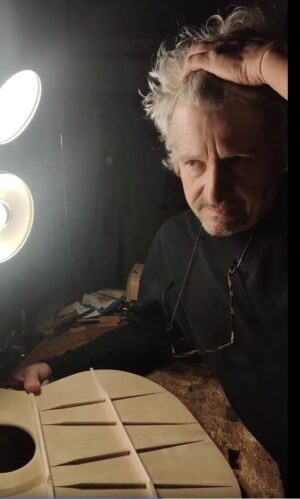
Luciano Lovadina is an Italian Classical guitar maker. He has his workshop in the city of Treviso. With more than 40 years of experience in guitar making, he has a very clear idea of what he wants in his guitars. His guitars have a very strong identity and originality of their own. The best way to get to know him is for him to talk about his work:
” I think experience is a very important thing in this job.
The knowledge accumulates over the years.
And doing this job I think is a bit like being a chef.
For this reason, raw materials are really important.
Of course, you need to know how to use it but to know how to choose it I think is fundamental…
And about the aesthetic of an instrument is very important I’ve never seen an ugly guitar that sounds good.
I’ve seen beautiful guitars that sound bad but never ugly guitars that sound good.
Therefore, the aesthetic taste goes together with the sound of an instrument.
So, an instrument to sound good must also be beautiful.
Cause guitar making is above all an art. It is not only a technique so it is necessary to know how to manage this beauty.
Must have a personal taste and a sense of the beauty of the instrument.
Anyway, I want to say when you take an instrument with your hand and you look at it the instrument must touch your soul.
it shouldn’t leave you cold. It needs to make you feel emotions…
Talking about the sound quality, the only winner card possible on the evolution of this instrument, and the research of better quality in this instrument is to try to ennoble the sound make it more musical make it more transparent and profound, and finally, give a greater musicality to the sound.”

DO YOU WANT TO BE INFORMED WHEN ANOTHER GUITAR FROM THIS GUITAR MAKER WILL BE AVAILABLE? LEAVE US YOUR EMAIL AND WE WILL KEEP YOU INFORMED.
FOR ANY QUESTIONS OR INFORMATION ABOUT THE UPCOMING AVAILABILITY OF A GUITAR FROM THIS GUITAR MAKER, PLEASE CONTACT US AT MADERA@MADERAGUITARRAS.COM
